IMPLEMENTING INDUSTRY 4.0: LESSONS LEARNED OVER TWO DECADES
MACHINABILITY OF PREFILLED SYRINGE PLUNGERS

IMPLEMENTING INDUSTRY 4.0: LESSONS LEARNED OVER TWO DECADES
MACHINABILITY OF PREFILLED SYRINGE PLUNGERS

OUTSTANDING ISSUE SPONSOR



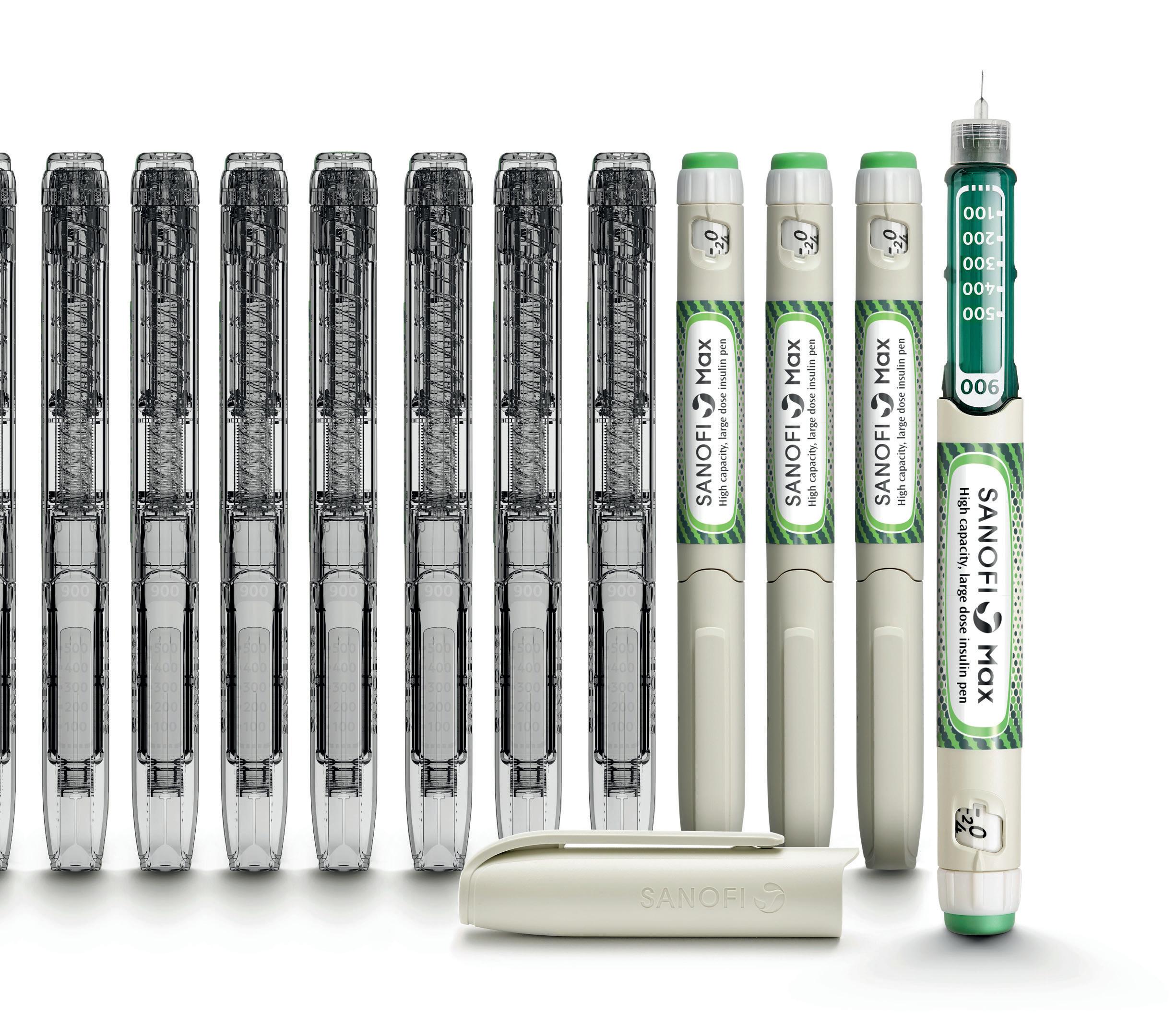
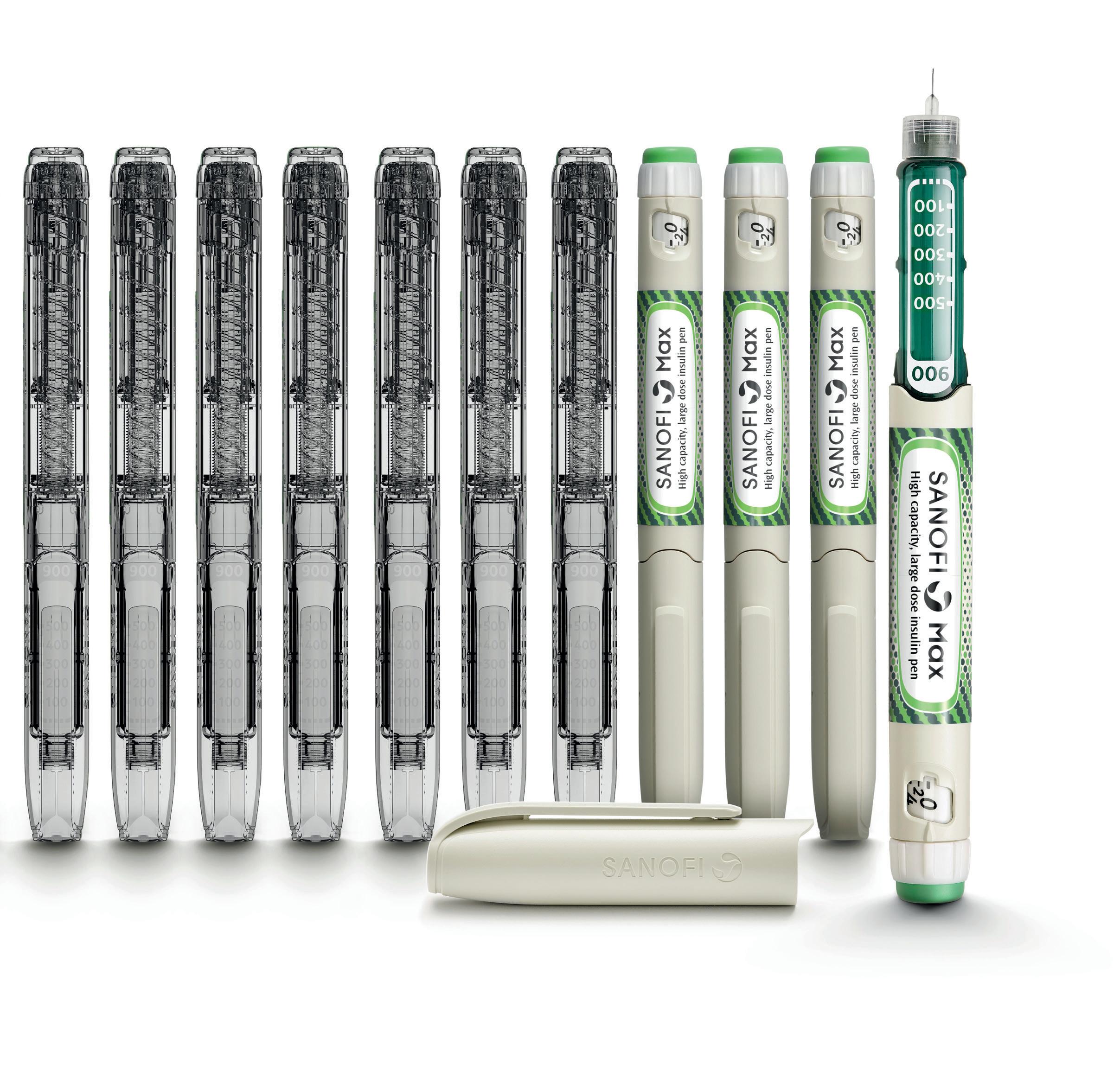
www.dca-design.com


ONdrugDelivery Issue No 163, July 17th, 2024
This edition is one in the ONdrugDelivery series of publications. Each issue focuses on a specific topic within the field of drug delivery, and is supported by industry leaders in that field.
EDITORIAL CALENDAR 2024/25
Sep 2024 Wearable Injectors
Sep/Oct Drug Delivery & Environmental Sustainability
Oct Prefilled Syringes & Injection Devices
Nov Pulmonary & Nasal Drug Delivery
Dec Connecting Drug Delivery
Jan 2025 Prefilled Syringes & Injection Devices
Feb Skin Drug Delivery: Dermal, Transdermal & Microneedles
Mar Ophthalmic Drug Delivery
Apr Pulmonary & Nasal Drug Delivery
Apr/May Drug Delivery & Environmental Sustainability
May Injectable Drug Delivery: Formulations & Devices
May/Jun Oral Drug Delivery
Jun Connecting Drug Delivery
Jun/Jul Industrialising Drug Delivery
EDITORIAL:
James Arnold, Managing Editor
E: james.arnold@ondrugdelivery.com
CREATIVE DESIGN:
Simon Smith, Head of Creative E: simon.smith@ondrugdelivery.com
SUBSCRIPTIONS:
Print + Digital subscription: £99/year + postage
Digital Only subscription: free. E: subscriptions@ondrugdelivery.com
ADVERTISING & SPONSORSHIP: Guy Furness, Publisher E: guy.furness@ondrugdelivery.com
ONdrugDelivery is published by Frederick Furness Publishing Ltd
The Candlemakers, West Street, Lewes East Sussex, BN7 2NZ, United Kingdom T: +44 1273 47 28 28
Registered in England: Company No 8348388 ISSN 2049-145X print / ISSN 2049-1468 pdf
Copyright © 2024 Frederick Furness Publishing Ltd

ONdrugDelivery Magazine is printed sustainably by Newman Thomson Ltd, West Sussex, UK, using Forest Stewardship Council® certified recycled paper, vegetable-based inks, biodegradable laminates and carbon balanced materials offset via the World Land Trust™ following ISO140001 processes. ONdrugDelivery in print is sustainably shipped to events by DHL using GoGreen Plus whereby carbon insetting of at least 30% is achieved through the use of Sustainable Aviation Fuel (SAF), a biofuel substitute for traditional jet fuel, produced from renewable sources such as vegetable oils, animal fats, waste products, and agricultural crops. The magazine is mailed to individual readers outside the UK by DHL using GoGreen, which offsets 100% of CO2 emissions.
The ONdrugDelivery logo is a registered trademark of Frederick Furness Publishing Ltd.
The views and opinions expressed in this issue are those of the authors. Due care has been used in producing this publication, but the publisher makes no claim that it is free from error. Nor does the publisher accept liability for the consequences of any decision or action taken (or not taken) as a result of any information contained in this publication.
06 - 09
Future-Proofing Your Drug Delivery Device: Considerations for Effective Design
Lorenzo Vaccarella, Director of New Product Development
Paragon Medical 12 - 15
Implementing Industry 4.0: Lessons Learned Over Two Decades
Herman Rusch, Chief Executive Officer; and Rob van den Brand, Chief Operating Officer
IGS GeboJagema 18 - 21
Using Efficient Proof-of-Concept Tests and Pilot Moulds for Device Development Success
Andreas Wild, Key Account Manager MedTech
Strama-MPS
Andreas Montag, Global Key Account Manager
Otto Männer
Ypsomed’s Platform Product Transformation and Approach to Strategic Partner Networking for Self-Injection Devices
Ian Thompson, Vice-President, Account & Business Development
Ypsomed
Machinability of ETFE-Film-Coated Prefilled
Syringe Plungers with Vent-Tube Insertion
30 - 34
36 - 39
40 - 45
48 - 53
54 - 57
Sebastien Cordier, Technical Product Manager; Benjamin Brocco, Marketing Manager; and Audrey Chardonnet, Business Development Director
Aptar Pharma
Edgar Bauer, Regional Sales and Business Development Director Europe
Bausch + Ströbel
Material Selection and Efficient Development Processes for Wearable Injector Drive Systems
Dave Beckstoffer, Business Development Manager
Portescap
Automating High-Mix, Low-to-Medium-Volume Autoinjector Assembly
Colby Chen, Senior Mechanical Engineer and Team Leader; and Ian Chang, Senior Control Engineer and Team Leader
SHL Medical
From Idea to Mass Production: Rapidly and Safely Industrialising Innovations
Michael Wiglenda, Global Senior Director Technical Competence Center & Moldmaking, Germany
Gerresheimer
Delivering Intelligent Autoinjector Assembly Solutions for Complex Customer-Specific Requirements
Lars Keinicke Hansen, Product Manager, Packaging and Assembly Stevanato Group




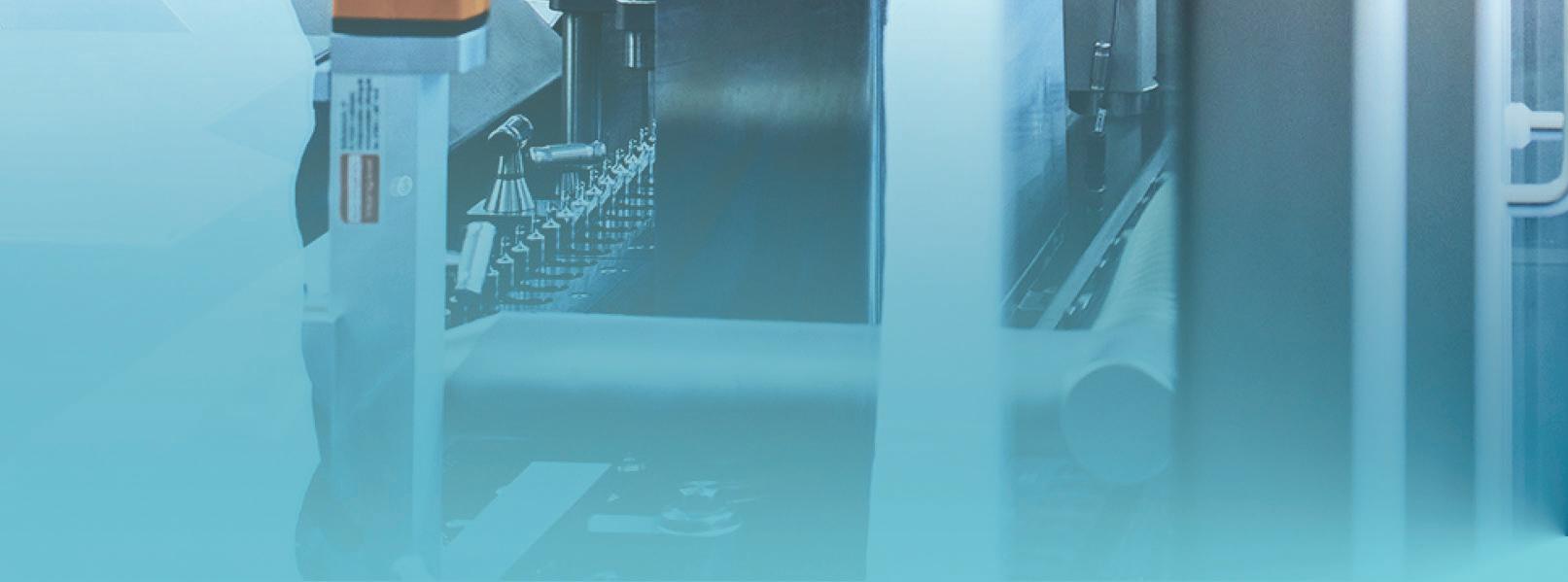

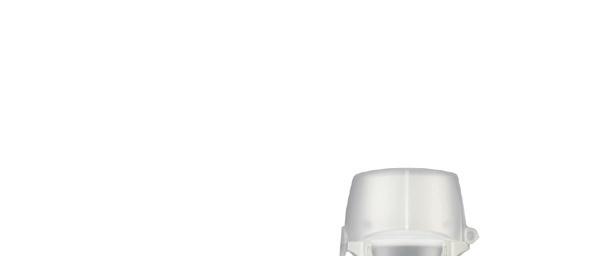
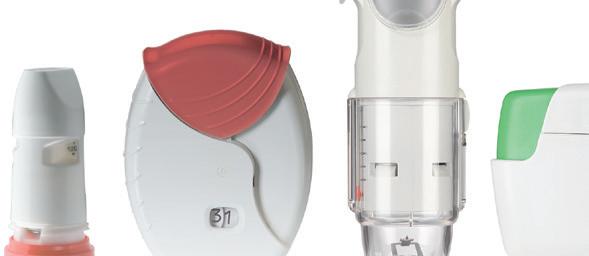
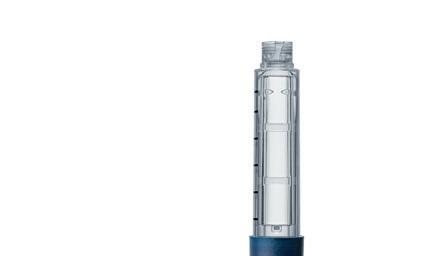
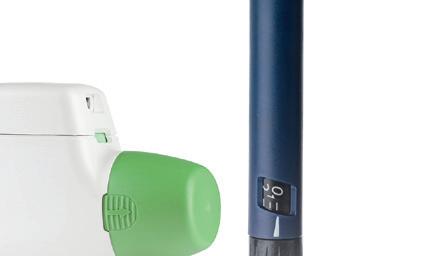
Here, Lorenzo Vaccarella, Director of New Product Development at Paragon Medical, highlights six critical areas to consider early in the drug delivery device development journey. He discusses how strategically investing time during the early stages of the design cycle and throughout development can ultimately save both time and cost down the road when the product is being manufactured and deployed into the market.
Injectable drug delivery device designs come in diverse forms, from pen injectors to autoinjectors and wearables. When designing such a device, it can be can be difficult to convey essential user requirements to design engineers in the initial sketches, potentially leading to challenges later in development. Conducting a voice of customer (VOC) exercise early on is crucial to understanding user needs and achieving the most suitable design for patients.
This early engagement provides ample time for necessary design adjustments, thus preventing wasting development time on creating prototypes, testing samples or manufacturing production parts. There have been many projects where design changes have stemmed from VOC exercises. One such project involved a glucose monitoring wearable device where the VOC exercise revealed that a light was required to enable users to view the information displayed by the device in dark or poorly lit areas.
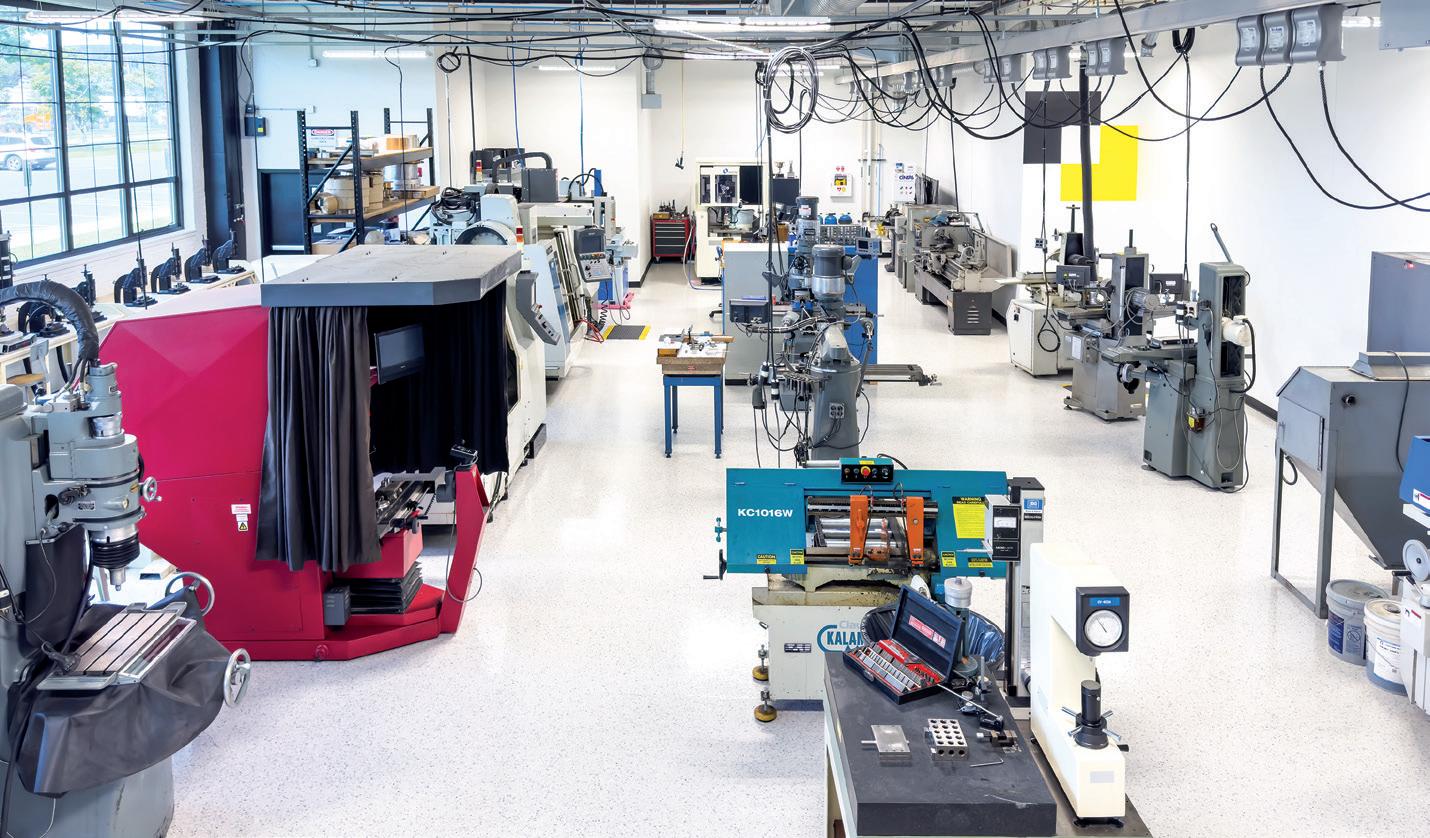

Lorenzo Vaccarella Director of New Product Development
T: +1 508 406 2117
E: sales@paragonmedical.com
Paragon Medical 111 Forbes Boulevard Suite 101 Mansfield
MA 02048
United States
www.paragonmedical.com
“Understanding how a drug is to be targeted or delivered is paramount to the overall design of the device.”
Sometimes, multiple prototype iterations are required to get the best functioning product that meets all user requirements. Paragon Medical has addressed this challenge with its Advanced Surgical Innovation Center (ASIC) in Southington (CT, US) (Figure 1). This facility enables the company to provide earlystage product samples in just 1–2 weeks, facilitating VOC exercises and enabling swift modifications to the design without jeopardising launch schedules. When it comes to designing drug delivery devices, understanding how a drug is to be targeted or delivered is paramount to the overall design of the device. Integrating human factors engineering very early on in a project is a critical aspect of drug delivery product development. Another element to understand is how patients and clinicians will interface with the drug delivery device itself, as this will help a designer further optimise the usability aspect of the device, as well as design-in features that will help minimise misuse of the device. Topics such as this are important to discuss with the manufacturer of the drug delivery device so that design optimisations can take place during the concept phase that will result in the most effective and user-friendly design possible.
Once the design concept has been developed, it is crucial to select the appropriate materials. A design engineer must first gather detailed information about the drug that is to be administered. If a material safety data sheet (MSDS) has been published for the drug, information such as proper storage and handling, toxicity and flammability can be easily obtained, which proves to be very useful for selecting the appropriate material. In the absence of a product specification sheet or MSDS, collaboration with customers is required to define these requirements.
Additionally, several other properties must be considered, including the target weight of the device, mechanical strength, chemical resistance, friction, viscosity and wear resistance. For example, when designing the outer shell of a combination product device, it is important to select a durable and costeffective material that will withstand impact and drop tests without compromising the “feel” of the outer shell. It is also crucial to factor in testing and processes such as transit, accelerated ageing and sterilisation. By thoroughly evaluating these aspects, it is possible to ensure that the product will withstand various storage environments and maintain its integrity and functionality throughout its lifecycle.
“By developing a testing plan early and conducting critical tests on the drug delivery device prototype, it is possible to see early trends of how the device will perform in its final state.”
“Once the design has been validated and initial testing completed, it is time to consider how the device will be scaled up for manufacturing.”
A common pitfall during drug delivery device development is delaying verification and validation (V&V) testing until after the design has been frozen and the V&V test part build completed, only to encounter testing failures that require subsequent design changes. An example of this is performing accelerated ageing testing on the packaging of a medical device and receiving failing test results. This necessitates a redesign of the display box that houses the product. By developing a testing plan early and conducting critical tests on the drug delivery device prototype, it is possible to see early trends of how the device will perform in its final state. The device does not need to be fully developed, nor does the testing need to be exhaustive. Benchmark variations can provide sufficient insight for determining if a design should be re-evaluated before investing in materials and equipment for production-equivalent parts.
Paragon Medical’s design and development team is proficient in a wide range of V&V testing methods and can execute these tests on behalf of customers to expedite the development process. Paragon’s testing services include mechanical, electrical, biocompatibility, transit, accelerated ageing and realtime ageing. The company can co-ordinate any additional tests agreed upon by the design and customer teams. Additionally, it performs design validation testing that simulates real-world conditions, such as animal studies, clinical trials and sterilisation validations (gamma, ethylene oxide, hydrogen peroxide, etc.). The company’s dedicated testing labs are equipped to handle these comprehensive evaluations.
Once the design has been validated and initial testing completed, it is time to consider how the device will be scaled up for manufacturing. When evaluating potential manufacturers, it is crucial to assess their experience and capability in high-volume manufacturing. Knowing that a manufacturing organisation has automation capabilities available within its infrastructure can be very attractive to a customer looking to scale up, as automation allows for the efficient mass production of drug delivery devices to meet increasing demand.
Furthermore, manufacturers with comprehensive capabilities – such as full-scale assembly, in-process testing, sterilisation and packaging – can offer significant added value by accelerating the time to market and reducing complexity in the supply chain. In response to the increased consumer demand for drug delivery devices, Paragon Medical has recently completed the expansion of its campus in Poland by adding another building dedicated to drug delivery device manufacturing (Figure 2). This expansion provides customers with the necessary space to scale up their drug delivery platforms efficiently.

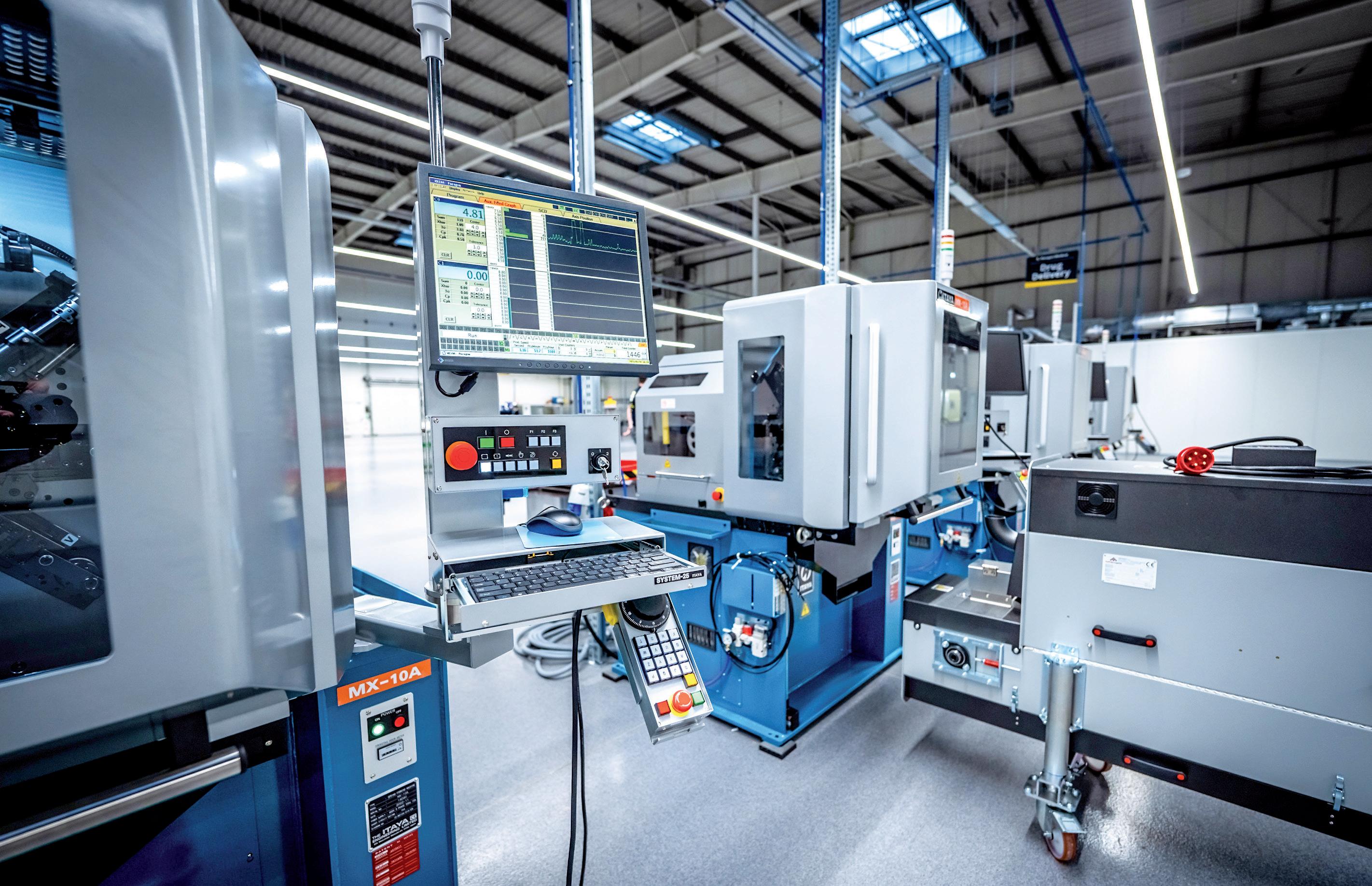
“Evaluating the manufacturing process early on can help identify high-cost operations and opportunities for efficiency.”
Evaluating the manufacturing process early on can help identify high-cost operations and opportunities for efficiency. At this stage, the development team can brainstorm modifications to the device design, such as performing a design-for-manufacturing evaluation to understand which parts can be injection moulded or fabricated out of metal. It is crucial to conduct these evaluations during the development phase, before the design is frozen and testing is completed, to avoid timeline delays and budget overruns from change orders during production. With this in mind, Paragon Medical engages its new product introduction (NPI) team, which focuses on manufacturing, alongside its new product development (NPD) team early in the product development phase. Involving manufacturing teams from the outset ensures that they understand the product thoroughly and are well prepared to devise effective manufacturing strategies.
The ever-changing regulatory environment continues to present the biggest challenge for medical device companies working on bringing drug delivery devices to market. The primary question to address is how to evaluate the safety and efficacy of such combination products. Therefore, it is crucial for manufacturing organisations
to involve a regulatory consultant early in the project. This allows the regulatory team to participate in the product development process and assess regulatory implications as the project evolves.
Balancing the demands of meeting market expectations while also capitalising on emerging opportunities can be a significant task. Moreover, managing a supply chain in today’s complex environment adds another layer of challenge. Manufacturing organisations must inspire confidence and trust among their customers by maintaining a robust and secure supply chain, especially knowing that procuring the required drug media is crucial for the commercial success of the drug delivery device.
To support mass production, it is essential to ensure that all materials are sourced cost effectively and meet customer requirements for timelines, quantities and quality. Supply, inventory and operations planning (SIOP) teams should collaborate closely with customers to facilitate conversations that drive cross-functional alignment and effective planning. A comprehensive SIOP process can help to foresee and eliminate obstacles and ensure that launch objectives are met.
“It is essential to ensure that all materials are sourced cost effectively and meet customer requirements for timelines, quantities and quality.”
It is of the utmost importance to maintain a flexible mindset early in the development phase of a drug delivery device. Conducting prototyping in the concept phase, engaging in VOC research, performing benchmark testing, reviewing the manufacturing process and consulting with regulatory affairs all contribute to a comprehensive understanding of the requirements for a successful drug delivery product.
Delaying these essential exercises until after the design has been frozen can lead to prolonged redesign processes, significantly impacting budgets and timelines. By investing extra effort in due diligence during the early stages of product development, companies can confidently progress towards full-scale commercialisation better equipped to navigate challenges and capitalise on opportunities in the dynamic landscape of drug delivery device innovation.
Paragon Medical is a partner for the drug delivery industry, serving as an extension of development teams by delivering operational excellence and sales, inventory and operations planning with over a century of combined expertise in high precision manufacturing, advanced engineering and design support. Paragon Medical is a strategic partner for medical device manufacturing, offering an end-to-end supply
chain solution from initial concept and product development to verification and validation testing, final production, assembly and ongoing strategic demand planning, with differentiated and personalised solutions designed to exceed expectations every time.
Lorenzo Vaccarella, Director of New Product Development, is a passionate, innovative and strategic engineering leader with over 25 years of experience within the medical device, medical capital equipment and medical interconnect assemblies industries. He has a proven track record of excellence in fast-paced and multidisciplinary environments, building productive customer relationships and translating customers’ needs into quality products. Mr Vaccarella has held both engineering individual contributor and leadership roles within three divisions of Johnson & Johnson (DePuy Orthopaedics, DePuy Spine and Codman & Schurtleff), two divisions of Medtronic (Advanced Energy and Minimally Invasive Therapies Group), Echo Therapeutics, Waters Corporation and Amphenol Alden. Mr Vaccarella holds a BS in Mechanical Engineering from Northeastern University (MA, US) and an MBA in Technology Management from the University of Phoenix (AZ, US).




CPHI Milan celebrates 35 years of pharma excellence – join the next generation of leaders, innovators & trailblazers.
Register now
8-10 October 2024
Fira Milano, Italy

At the heart of Pharma

In this piece, Herman Rusch, Chief Executive Officer, and Rob van den Brand, Chief Operating Officer, both of IGS GeboJagema, present four lessons for implementing Industry 4.0 technology and practices in the drug delivery industry, which the company has learned during its own journey to Industry 4.0 over the past 20 years.
The market for drug delivery devices is skyrocketing, presenting the industry with the critical challenge of keeping pace with the growing demand both efficiently and affordably. This challenge is compounded by a shortage of skilled, technical workers in many countries. All these factors point towards a clear solution – Industry 4.0 (Figure 1). This broad term encompasses the digitalisation of manufacturing,
opening the door to new technologies and highly advanced automation. Industry 4.0 (and its 5.0 successor) will become crucial over the next couple of decades for achieving the necessary production capacity to serve a growing world population. Moreover, it will allow the drug delivery sector to reduce costs while maintaining quality, thereby improving accessibility of healthcare to the global population.

Herman Rusch
Chief Executive Officer
T: +31 40 2647500
E: sales@igsgebojagema.nl

Rob van den Brand
Chief Operating Officer
T: +31 40 2647500
E: sales@igsgebojagema.nl
IGS GeboJagema
Esp 430
5633 AJ Eindhoven
The Netherlands
www.igsgebojagema.nl
IGS GeboJagema was one of the first organisations in the industry to place this insight at the core of its strategy. Over the past 20 years, the company has transformed its facility into a 24/7, lights-out, hands-off factory for the production of high-precision injection moulds. In 2015, the company’s automation reached the level where its factory was more productive outside business hours, after the IGS GeboJagema team had gone home, than it was during the working day. As evidence of this, the company’s revenue per employee is 75% higher than the market average.
Industry 4.0 has been a successful choice for IGS GeboJagema, but its implementation has certainly not been without its challenges. While it is easy to purchase robots and machines, the real challenges lie elsewhere. Implementing Industry 4.0 requires an entirely new way of thinking, a new organisational culture and carefully steering past numerous pitfalls.
It is true that implementing Industry 4.0 can lead to enormous efficiency gains; however, it is crucial to be aware of its “all or nothing” nature. Every component in the production chain must work together flawlessly. A single weak link will disrupt production and negate the many possible benefits that Industry 4.0 can provide. This reality stresses the importance of precision and reliability in every part of the process. All systems, machines and tools, down to clamps and holders, must meet the highest standards. Constant monitoring and regular maintenance are essential to ensure that everything performs


reliably, every second of every day. Achieving this requires a culture within the organisation of meticulous attention to detail and high quality standards. For most organisations, this requires a significant shift in culture.
The real power of Industry 4.0 lies not just in cutting-edge technology, but in the processes that underpin it. As discussed, achieving a flawless production process is paramount. The key word here is “flawless”. Implementing Industry 4.0 is about systematically removing any room for error in the production process, from start to finish. For this reason, IGS GeboJagema did not start its implementation on the factory floor, but instead initially focused its knowledge and expertise on the engineering department.
First, the company prioritised the manufacturability of its moulds, with the IGS GeboJagema team designing all new moulds
not only to meet customer requirements but also to be easier to manufacture. This upfront investment prevented many possible complications during production. Second, the organisation made the switch from traditional 2D drawings to modelbased definition (MBD). MBD uses 3D models that hold all necessary product information (Figure 2), eliminating the interpretation and communication issues that are inevitable when using 2D drawings. MBD creates a single source of truth that is accessible to all relevant departments and machines and allows for further automated programming in computeraided manufacturing (model-based manufacturing) and metrology (modelbased inspection).
In short, the first step is not to purchase machinery, but to lay the groundwork for a comprehensive Industry 4.0 ecosystem. This transformation demands a holistic organisational shift, making Industry 4.0 more akin to a new operational ethos than a technological solution (Figure 3).

Industry 4.0 changes the way the entire organisation works. While some employees may welcome these changes with enthusiasm, many team members will be sceptical and have concerns. It is crucial to communicate to all employees why the shift to Industry 4.0 is necessary and what they can expect. One fear for employees is, of course, that their jobs will be replaced by machines, putting their livelihoods at risk. In truth, the opposite is the case. Companies that innovate and invest in automation become more competitive, thereby strengthening their employees’ job security. IGS GeboJagema is a prime
“Companies that innovate and invest in automation become more competitive, thereby strengthening their employees’ job security.”
example of this, having more than tripled its revenue over the past 10 years while also expanding its workforce.
Industry 4.0 will also change the nature of many jobs. The biggest shift will occur


on the factory floor. In traditional factories, craftsmen use their technical skills to create a component from start to finish. In an automated production environment, on the other hand, these craftsmen use their expertise to focus on logistics, quality and production management. Their work involves using an enterprise resource planning system and 3D files to ensure that their part of the production process is executed flawlessly.
Many employees enjoy working with cutting-edge technology and find that it enriches their work. In particular, IGS GeboJagema has learned that it has become easier to recruit young talent who find it more appealing to work in a hightech environment. Between 2012 and 2023, the average age of the company’s employees dropped from 48 to 38. Of course, the reality will be that a number of team members will find the new way of working does not suit them. However, with abundant and clear communication, IGS GeboJagema has found that this is the case for only a small minority of employees.
Standardisation is key for Industry 4.0 to succeed (Figure 4), but standardisation inevitably also makes a production environment more rigid and inflexible. One challenge for IGS GeboJagema has been to make room for quick responses to emerging issues. For instance, if, during validation, it is discovered that a mould requires adjustments in the milling department, this extra work can disrupt the entire production process.
To navigate this challenge, IGS GeboJagema has established a dedicated quick-response manufacturing department. This separate, flexible and multifunctional team is focused on addressing immediate and unforeseen needs. It ensures that rapid adjustments and validations can be handled without disturbing the main production flow. This approach not only preserves the efficiency and standardisation of the automated process, but also introduces an essential layer of flexibility.
Industry 4.0 is not without its challenges and adopting it is not an overnight process. However, IGS GeboJagema believes that
this direction offers enormous potential for the industry. The benefits of the transition have been proven, and there are still many opportunities to explore for the company, ranging from automated milling corrections and automated guided vehicles to artificial intelligence (AI).
But Industry 4.0 is not the endpoint – the transition towards Industry 5.0 has already begun (Figure 5). This next phase is centred on the synergy between humans, technology and the environment. It promises to enhance not only the efficiency
but also the sustainability of production methods, through technologies such as autonomous mobile robots and further integration of AI, not only in production but also in office operations.
IGS GeboJagema believes that it is critical for the drug delivery industry to embrace these technological advancements.
The transition to Industry 4.0 and 5.0 is how the industry will ensure that healthcare becomes more affordable and accessible to the billions of inhabitants of the planet.
IGS GeboJagema is a high-precision mould maker that designs, manufactures, validates and maintains moulds for products where extreme precision is vital, from glasses and contact lenses to asthma inhalers, insulin pens and blood diagnostic devices. IGS GeboJagema specialises in collaborating with medical original equipment manufacturers early in the product lifecycle, allowing its exceptional engineering team to develop innovative moulding solutions.
Herman Rusch is the Chief Executive Officer at IGS GeboJagema. He brings a strong background in mechanical engineering to the role, including an MSc, as well as experience in the high-tech semiconductor sector, with previous roles in operations, business management and general management. Before joining IGS GeboJagema in 2023, Mr Rusch’s career spanned several large international original equipment manufacture companies, including Philips, BESI, ASML and VDL.
Rob van den Brand serves as the Chief Operating Officer at IGS GeboJagema and is responsible for the company’s operations in Eindhoven and Peachtree City. With a Bachelor’s degree in Mechanical Engineering and a Master’s degree in Supply Chain Management, Mr van den Brand has a strong focus on production excellence and Industry 4.0 automation and digitalisation. Having worked at IGS since 2005, Mr van den Brand has a keen insight into what it takes to keep developing the company towards the next industrial revolution.
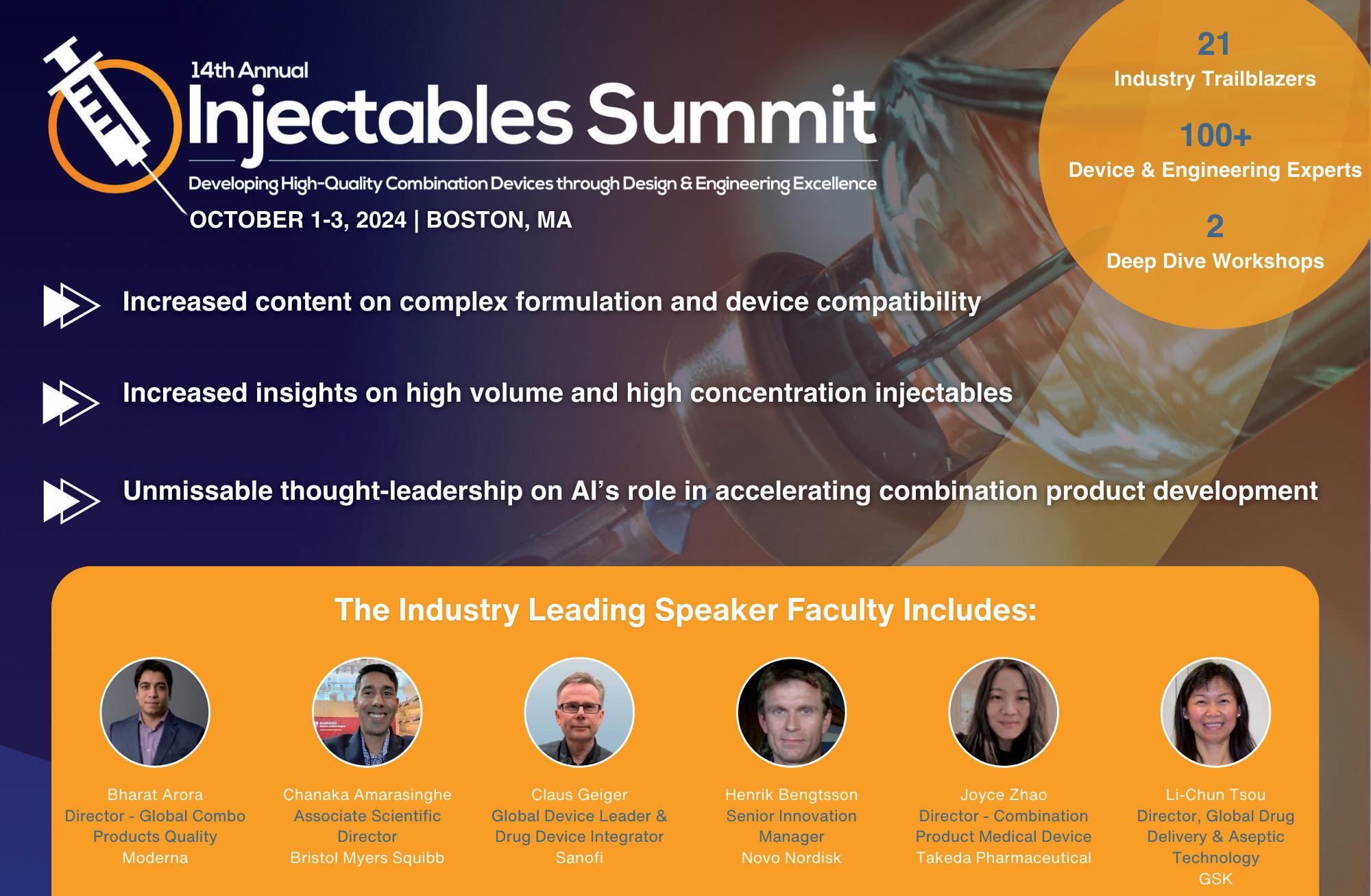


THE WORLD’S LEADING MOULD MANUFACTURER 300+ MOULDS MANUFACTURED ANNUALLY


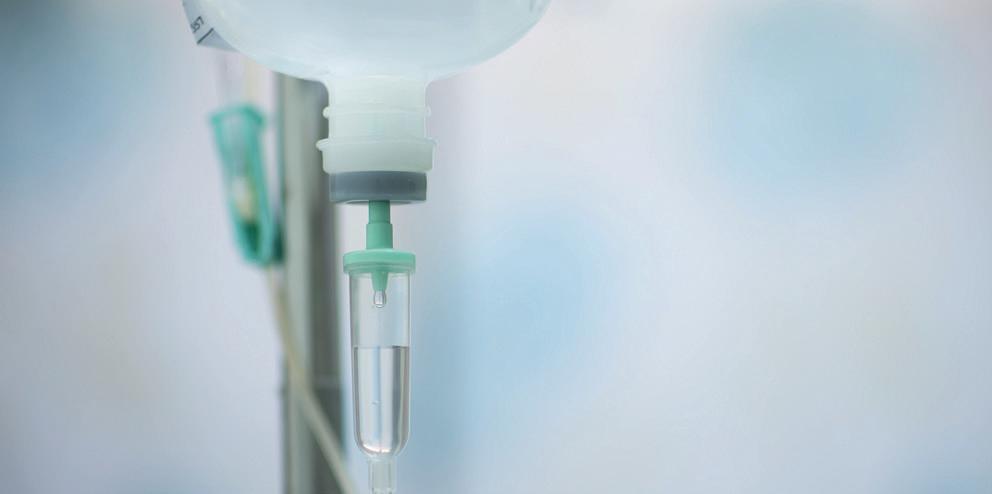
When it comes to people’s health, nothing but the very highest standards will do. That’s what drives IGS GeboJagema to push the envelope every single day. Based in the heart of the most prominent technology hub of Europe, we have assembled a team of world-class engineers. Through their ambition and creativity, we develop cutting-edge and highly reliable moulding solutions for the healthcare market.
IGS GeboJagema combines unrivalled technical expertise, smart innovations and rigorous testing with the latest technology and the highest specifications of materials. By working closely with medical OEMs early in the product life cycle, we allow our clients to take full advantage of our engineering power. It’s how we deliver unique, innovative solutions that give our clients an edge over their competitors.
Join us in creating the future of injection moulding and discover how our team can make your production easier, faster and less expensive.

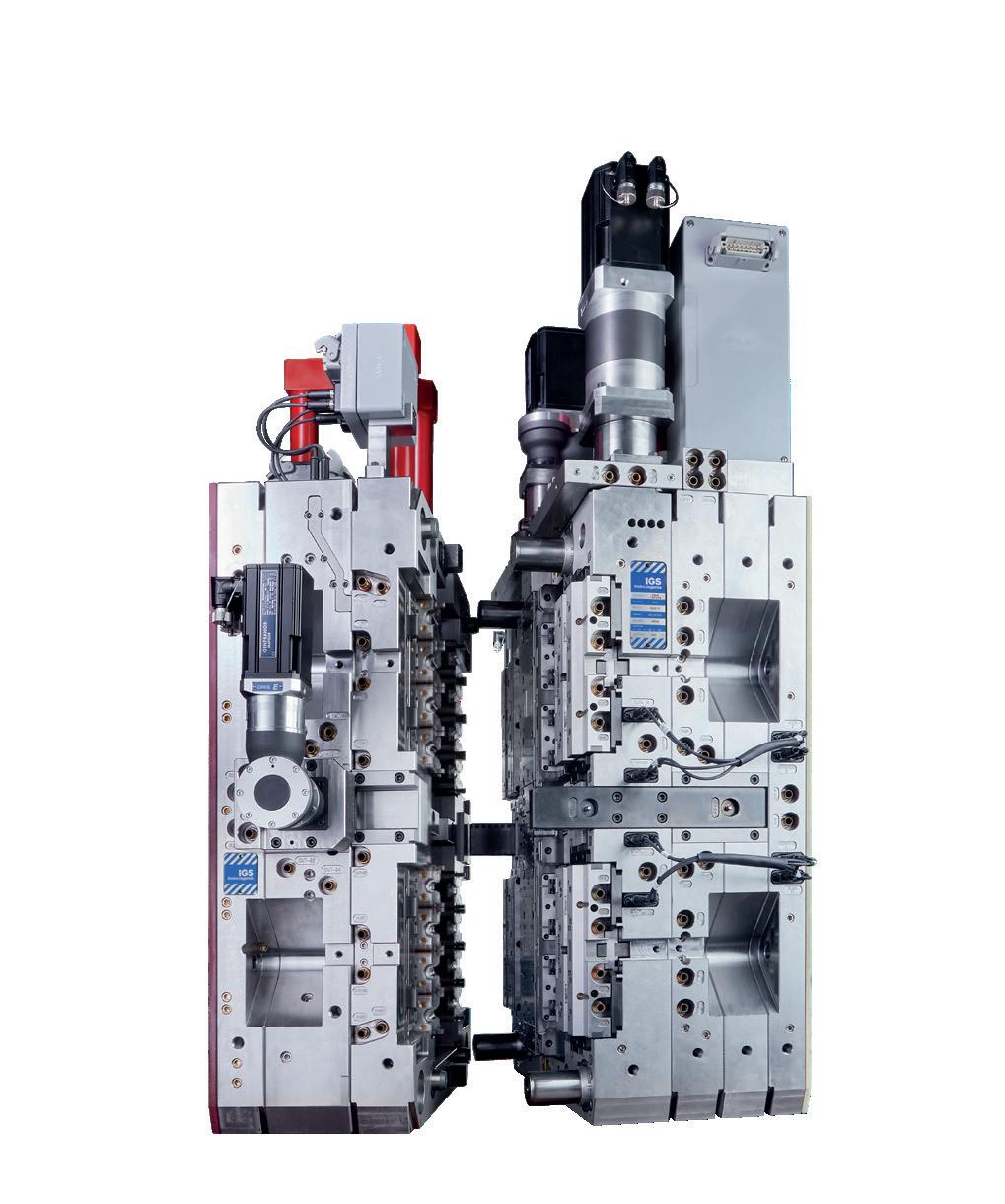
In this article, Andreas Wild, Key Account Manager MedTech at Strama-MPS, and Andreas Montag, Global Key Account Manager at the Foboha and Otto Männer section of Barnes Molding Solutions, discuss the value of early proof-of-concept testing and sample production for drug delivery device development projects, with an emphasis on how partnership and consultation can smooth and enhance this process, including for design for automation and design for manufacturing considerations.
The rapid development of the pharmaceutical industry requires innovative and efficient drug delivery devices to meet the needs of patients and the healthcare sector. These specialised devices play a crucial role in the administration of drugs to patients, as they have a significant effect on the efficacy, safety and user-friendliness of the delivered therapy. With increasing competition and stricter regulatory requirements, the industrialisation of drug delivery devices has become a critical factor for success in the market.
The development of drug delivery devices is a complex task that requires specialised expertise. The process involves not only the design of the device itself, but also consideration of technical feasibility, cycle times, the design of injection moulding and assembly tools and assessment of costs.
There are three often conflicting perspectives on design that need to be reconciled.
Functionality and Market Requirements
These requirements are, of course, the highest priority. All considerations regarding well-functioning production and assembly are rendered moot if the product does not fulfil the requirements of the market and the regulatory specifications for approval and, therefore, cannot be sold.
Injection Moulding Tool Requirements
The injection mould is a crucial element for producing precisely shaped parts. The requirements for injection moulding tools can vary depending on the specific requirements of the part to be produced. However, the following are some general requirements:
• Precision: The mould must be extremely precise to ensure that the manufactured parts meet the required specifications. This includes the exact shape, size and surface finish of the final product.


Andreas Wild
Key Account Manager MedTech
T: +49 9421 739 410 M: +49 1525 6870 410
E: andreas.wild@strama-mps.de
Strama-MPS Maschinenbau GmbH & Co KG Ittlinger Str 195 94315 Straubing Germany
www.strama-mps.de/en

Andreas Montag
Global Key Account Manager T: +49 171 8458522
E: amontag@onebarnes.com
Otto Männer GmbH Unter Gereuth 9-11 79353 Bahlingen a.K. Germany
www.onebarnes.com

• Durability and Material Selection : The tool must be made from high-quality materials that can withstand the demands of the injection moulding process. Typically, tool steels, such as P20 or H13, or those with higher wear resistance are used to ensure a long mould life.
• Cooling: Effective cooling is critical to ensure that the material solidifies evenly and that shrinkage or deformation problems are minimised. The mould should have an efficient cooling system that ensures an even temperature distribution.
• Venting: The mould must have sufficient venting channels to ensure that gases produced during the injection moulding process can escape. This prevents the formation of air pockets or bubbles in the manufactured parts.
• Automation Capability : Modern injection moulding tools can be equipped with automation functions to optimise the production process. This can include the integration of demoulding systems or robots for part removal.
• Ease of Maintenance: A good mould design takes ease of maintenance into account. This means that the tool should be easy to disassemble, clean and maintain so as to minimise downtime and extend the life of the tool.
In addition to joining tolerances, positioning tolerances suddenly come into play here (Figure 1). Additionally, it is important to consider the design of chamfers and joining aids, or surfaces and moulds for gripping, to provide counterforce during joining.
The earlier this tension is analysed and resolved, the faster samples for proof-ofconcept (PoC) studies or clinical trials can
“In order to unite all interests, design for automation, DfA or DfM studies can be carried out with all interest groups at an early stage.”
be created. In order to unite all interests, design for automation, design for assembly (DfA) or design for manufacturing (DfM) studies can be carried out with all interest groups at an early stage (Figure 2). The terms of these studies are often not standardised – each company defines them slightly differently. Regardless of which aspects are included in which area, it is ultimately a matter of addressing early on how a later marketable device can be manufactured in sufficient quantities with the simplest possible processes and low unit costs (Figure 3).
However, it is not only functional and manufacturing aspects that should be considered here. Against the background of the risk-based approach outlined by GMP guidelines, test characteristics and criteria can already be defined. The questions that often only arise during the design and building of a machine for series production are familiar ones to all device developers, for example:
• How is a correct joining process defined?
• What is a good surface?
• When is the product “damaged”?
If these questions are not only discussed in the initial concept studies, but also tested – and ideally specified and qualified – in advance with the help of PoC studies, a lot of preparatory work will have already been done for the smooth development of series production. This begins with the creation of the drawing for the injection moulded part and, therefore, with the production of the injection moulding tool for the first prototypes.

The industrialisation of drug delivery devices requires a multidisciplinary team that combines expertise in the areas of injection moulding, automation, production and assembly with knowledge of the functionality and market requirements of the device. While many manufacturers have this knowledge in-house and there are often colleagues with many years of experience in these areas, it is sometimes worth looking outside the box – external partners are often familiar with very different approaches due to their collaboration with several medical technology manufacturers and can certainly bring a breath of fresh air, new perspectives, additional experience and ideas.
The development of new products and the series production of existing products are often done simultaneously at most companies. In-house specialists for injection moulding, production, assembly and process are frequently involved in ongoing operations and cannot provide the time that a new product actually needs for its development. In such cases, the early involvement of an external partner can be invaluable.
The perspective on a production and assembly drawing can be very different across specialisms. Some tolerances may be seen as too tight or too wide from the point of view of assembly specialists. Whereas, from the point of view of plastics engineers, maintaining some tolerances can be considered complex against the background of shrinkage and thermal deformation during cooling. At the same time, the manufacture of a high-quality product often requires relatively tight tolerances with little clearance between the components. Last but not least, a controller will also speak up and urge compliance with costs. Such a conflict can only be resolved by having all the experts at the same table and, in a second step, real sample parts from a pilot mould.
Pilot moulds offer several advantages:
• Rapid Prototype Production : A pilot injection mould enables the rapid production of prototypes or small series parts. This is particularly useful for validating design concepts or testing new products prior to mass production.
• Cost Efficiency: Compared with full production moulds, pilot injection
“External partners are often familiar with very different approaches due to their collaboration with several medical technology manufacturers and can certainly bring a breath of fresh air, new perspectives, additional experience and ideas.”
moulds are generally cheaper to produce. This enables companies to carry out prototyping and test runs without having to invest heavily in expensive moulds.
• Flexibility and Adaptability : Pilot injection moulds are often easier to adapt and modify than production tools. This allows engineers and designers to respond quickly to feedback and requirements and make changes to the design or manufacturing parameters.
• Fast Time to Market: By using a pilot injection mould, companies can bring products to market faster. This is particularly important in industries with short development cycles or rapidly changing market requirements.
• Fault Detection and Optimisation : By producing prototypes with a pilot injection mould, engineers can identify potential problems at an early stage and rectify them before mass production begins. This helps to avoid production downtime and expensive reworking.
• Material and Process Development: Pilot injection moulds also make it possible to test and optimise different materials and process parameters. This is particularly useful when developing new materials or fine-tuning the injection moulding process for optimal results.
• Market Research and Customer Feedback: With prototypes produced using a pilot injection mould, companies can conduct market research and gather customer feedback before making major investments in mass production. This helps to ensure that the final product meets the requirements and expectations of the target patient group.
Overall, using a pilot injection mould provides a cost-effective and efficient way to produce prototypes, test products and accelerate time to market, resulting in accelerated product development and improved competitiveness.
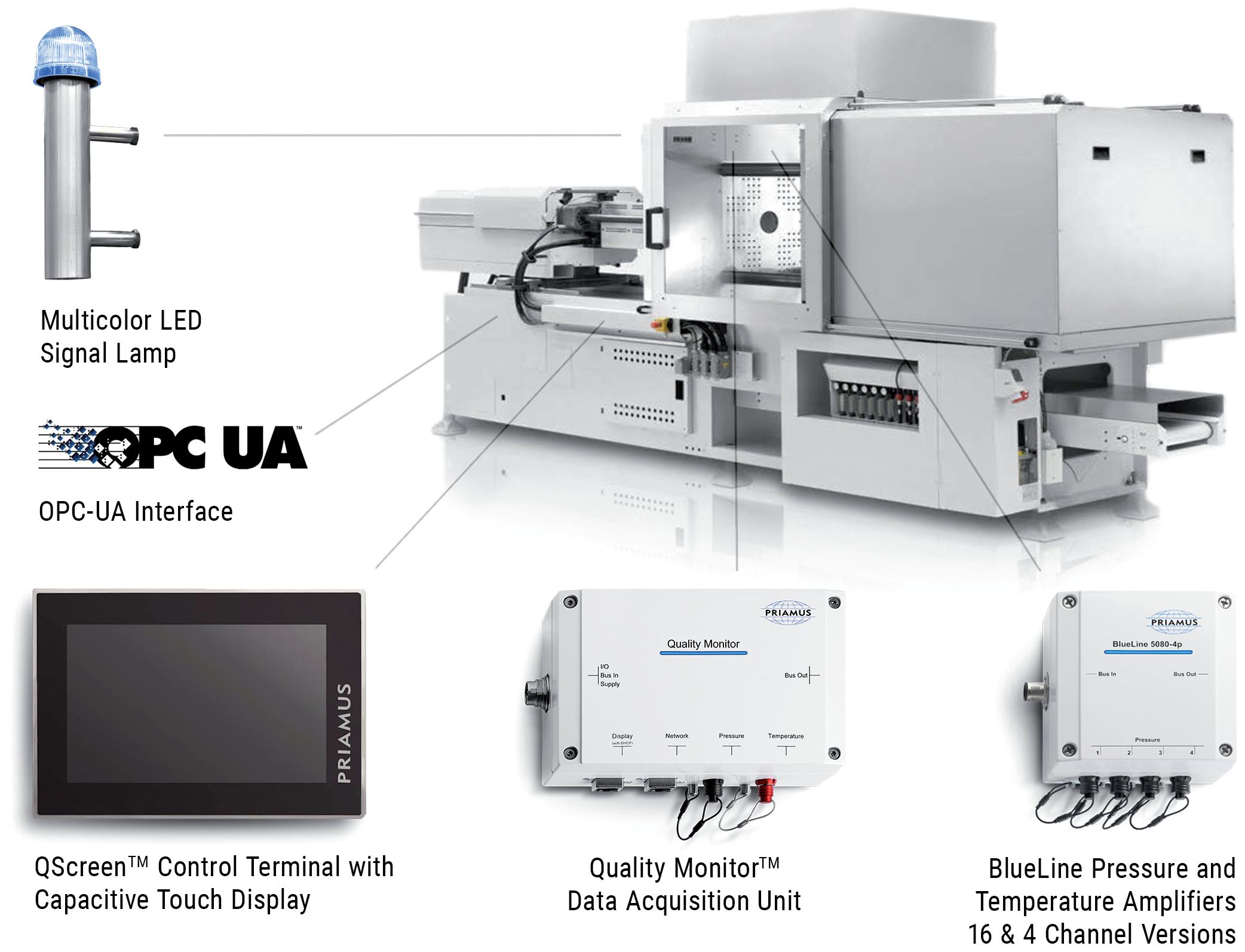
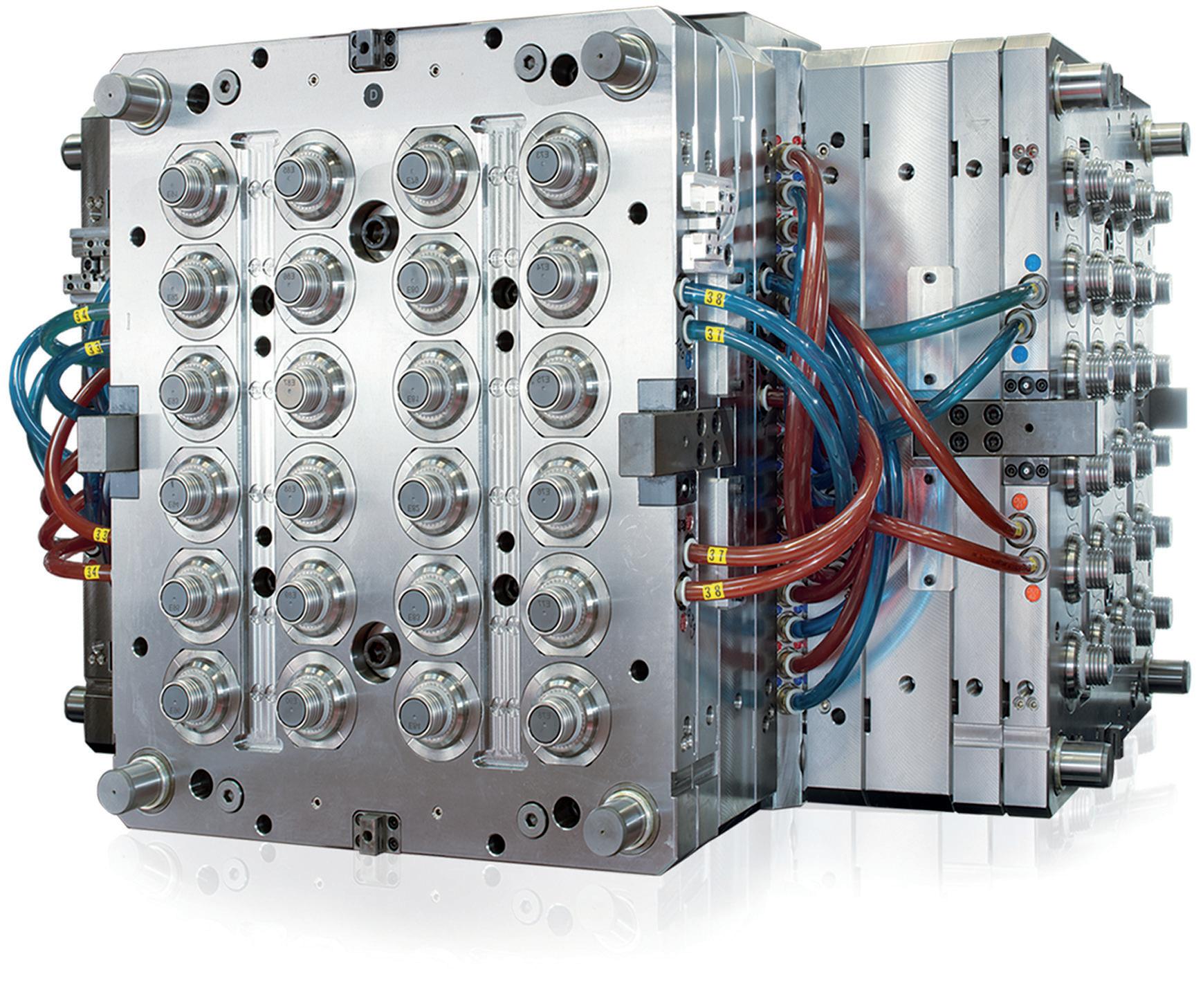
For optimal results, a partner with experience in injection moulding, assembly and automation technologies can be involved in the design of the medical device right from the start. This way, design errors can be identified and rectified at an early stage. Working with an experienced partner also allows medical device manufacturers to draw on innovative ideas, outside experience and best practice in automation technology to ensure an optimised design (Figures 4 & 5).
At the same time, working with an experienced partner enables companies to focus on other aspects of drug delivery device development, namely the functionality, market acceptance and regulatory requirements of the product. For example, adapting to the new EU MDR is currently tying up significant capacity for almost all companies in the market. The personnel and expertise freed up by working with external partners can then focus their efforts on facilitating the authorisation of the drug delivery device and overcoming regulatory hurdles.
The considerations discussed in this article can have a significant impact on the quality, costs and lead time of the development of a drug delivery device. Especially when considering that the time from the first sketch to the first shot is most often several months, it is worth starting these investigations at an early stage, potentially
with an experienced external partner. Rapid PoC and sample production are essential to speed up product development and minimise risks. An experienced partner can create prototypes and samples quickly and, if necessary, build fixtures for joining to validate the design in order to identify possible weak points for automated handling and joining at an early stage.
Once mutual trust has been built up between device developer and production partner in the development and PoC phase and matured to the point that the decision is made to continue working together on the path to series production, the jointly generated knowledge can very quickly be put to profitable use. This optimises the development process and shortens the time to market – the parameters for injection moulding are already
known, the required joining accuracies have been established and test plans for subsequent installation qualification and operational qualification tests have already been written.
Ultimately, the decision to seek advice from a partner who is familiar with design for automation, DfM and DfA from the outset is of great importance for successfully industrialising drug delivery devices. It is an investment that pays off in the long term and helps medical technology manufacturers to develop innovative and high-quality solutions for patients.
This article was originally published in German in meditronic-journal.
Strama-MPS specialises in the development and manufacture of state-of-the-art automated assembly solutions and testing technology. With a long history of success and a strong focus on innovation, quality and customer satisfaction, Strama-MPS is internationally recognised as a reliable partner in the manufacturing industry. As part of the Strama Group, the company offers customised automation solutions that help to increase efficiency and productivity in various industries.
Foboha and Otto Männer are leading brands within Barnes Molding Solutions, a pioneer in the plastics industry. Through high-precision injection moulds, the company offers tailor-made solutions to optimise manufacturing processes. Foboha and Otto Männer’s expertise and innovations are an integral part of Barnes Molding Solutions’ industry-leading products and services.
Andreas Wild is a Key Account Manager for MedTech at Strama-MPS. He has 20 years’ experience in special machine building, having held roles as an application engineer, project manager and in sales. Over the past 10 years, he has prepared and moderated several DfM/DfA workshops for different drug delivery devices.
Andreas Montag is a Global Key Account Manager in the Foboha and Otto Männer section of Barnes Molding Solutions, with experience in new customer acquisition and existing customer support in the medical technology industry and extensive knowledge in the development of production and automation concepts. His experience as a product owner for pipette tip automation and the successful development of a major customer in the key account underline his skills in the area of DfM and DfA for injection moulded parts.


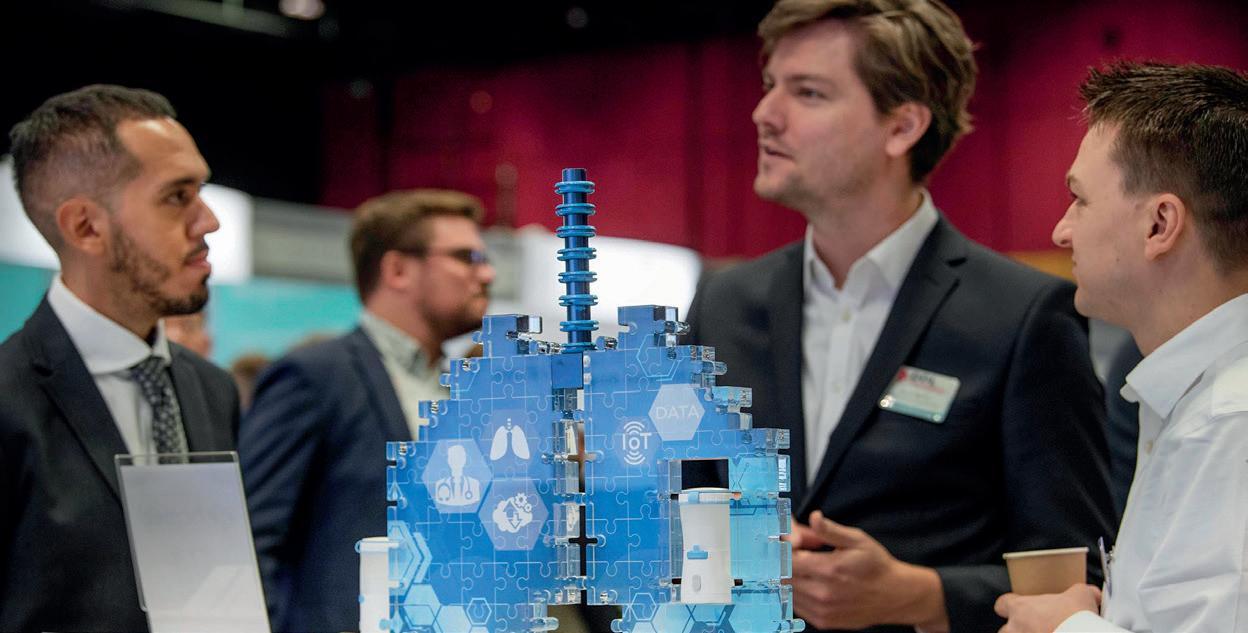
The Premier International Pulmonary and Drug Delivery Conference 11/12/13th December 2024
Edinburgh International Conference Centre or virtual
The DDL Conference is in its 35th year and attracts in excess of 1000 attendees worldwide. The conference includes a large industry exhibition, supported by over 100 international companies, a scientific poster hall, expert lectures and excellent networking opportunities over the 3-day event.
Anniversary Gala Dinner
A complimentary dinner and evening entertainment for all attendees held at the National Museum of Scotland.



Enhance your product development with Sanner Group’s Design Center of Excellence design experience combined with the state-of-the art manufacturing capabilities. From design and engineering right through to state-of-the-art manufacturing, we’re here to help.
Bring your devices to life with the support of a multidisciplinary team of experienced engineers and scientists at your fingertips. We offer a turnkey service and can help you and your team at each step of the journey.
Springboards’ areas of design-development expertise include drug delivery devices such as autoinjectors, infusion pumps, inhalers and syringes, other medical specialities in the fields of respiratory, surgical, critical care, implantables, diagnostics and biotechnology devices.
Sanner has extensive manufacturing and injection molding expertise in cleanroom environment with robust production processes offering state-of-theart manufacturing capabilities in Europe, Asia and soon in the US.
Sanner Group is agile, reliable and we stand by our word. Our robust procedures and equipment deliver high quality and highly competitive products.
Get your product to market faster with collaborative teams working seamlessly on new ideas in device design, device development, prototyping, automated production and assembly.
Please contact our experts to discuss your request:
• sales@sanner-group.com
• www.sanner-group.com
Here, Ian Thompson, Vice-President, Account and Business Development at Ypsomed, describes how Ypsomed has transformed the market for platform-based selfinjection devices and extended the concept of platform products beyond the core device by developing working practices with strategic networking partners, helping pharma companies and patients to source safe, reliable and easy-to-use drug-device combination products.
In 2023, global pharma sales were estimated at US$1.6 trillion (£1.3 trillion), with the top 25 global pharma companies accounting for around 50% of these sales. Today, biologics account for more than $500 billion, or just over 30% of global pharma sales. This proportion is set to grow further as pharma develops more self-injectables in the therapy areas of oncology, neurology and rare diseases, in addition to the larger and growing markets for treating broader autoimmune diseases and insulin/glucagon-like peptide 1 (GLP-1)-based drugs for treating diabesity.
With an approximately 15% spend on R&D and average cost of goods at around 25%, pharma invests around $650 billion in R&D and operations, with as much as half outsourced to a broad range of organisations, including contract research organisations (CROs) for R&D and contract development and manufacturing organisations (CDMOs) for manufacturing. Outsourcing is a key activity for pharma companies and their supply chains have become global and complex. With more outsourcing, new modalities and novel ways to reach patients, it is critical to ensure that outsourcing networks are robust and can withstand shocks.
The platform approach for injectable drug delivery devices emerged through the use of standardised, ready-to-fill prefillable syringes, for the injection of heparins and vaccines, and prefilled cartridges, for insulin and dental lidocaine. Many of these innovations were introduced in parallel with the development and growth of the markets for these molecules in the 1980s and 1990s. During that time, the self-injection market developed with more dedicated bespoke devices as insulin and human growth hormone (hGH) were developed and needed to be dosed using an accurate pen mechanism for frequent, typically daily, injections. In the 1990s and 2000s, the development of interferons and monoclonal antibodies (mAbs) led to the introduction of automated spring-driven autoinjectors for less frequent injections based on fixed doses. Until 2006, when the first handheld prefilled autoinjectors were launched, there were relatively few self-injection devices on the market. At that time, the market was dominated by insulin pens from major manufacturers such as Novo Nordisk, Lilly and Sanofi and the first prefilled autoinjectors for the two anti-tumour necrosis factor (TNF) antibodies Humira® (adalimumab, AbbVie) and Enbrel® (etanercept, Amgen).

Ian Thompson Vice-President, Account & Business Development
T: +41 34 424 3223 E: ian.thompson@ypsomed.com
Ypsomed AG Brunnmattstrasse 6
CH-3401 Burgdorf Switzerland
www.ypsomed.com/yds
“The 2000s were transformational for both injection pens and autoinjectors with the introduction of platformbased business models and a growing number of drug product launches in the 2010s.”
The 2000s were transformational for both injection pens and autoinjectors, with the introduction of platform-based business models and a growing number of drug product launches in the 2010s. The term “platform product” refers to a standardised self-injection device technology that can be adapted to the needs of a variety of drugs while being supplied from common manufacturing infrastructure. Already established in other industries, platforms serve to de-risk and accelerate the development and manufacture of a variety of customised product iterations. In contrast to bespoke devices designed for individual drugs, platform products are versatile and can accommodate varying drug requirements, such as primary packaging configuration, dose volume and drug viscosity.
There has recently been a notable shift towards customising platforms to create a spectrum of drug-device combinations, resulting in simplified access to advanced
drug-device combination products for a wide range of biopharmaceutical customer segments, including small biotechnology innovators, emerging biosimilar manufacturers and global big pharma companies – the latter often adopting a platform-in-platform approach to further streamline the serial launch of injectable drug-device combination products with proven supply chains, partnerships and manufacturing infrastructures.
Pharma has developed four key elements to improve supply-chain resilience for its drug products:
• Mapping suppliers with end-to-end transparency to fully understand the supply chain and identify potential vulnerabilities
• Performing routine stress testing and reassessment, often entailing regular audits of critical suppliers
• Reduction in exposure to shocks through multisourcing and striking a balance between just-in-time and just-in-case inventory levels
• Ensuring that supply-chain risk and resilience is embedded in both strategic planning and day-to-day execution, with structured governance to ensure that decisions are made and acted on at the right level and time.
All of these aspects are mirrored within Ypsomed Delivery Systems’ structures and processes, which are designed to develop

long-lasting and trusting partnerships with pharma customers. Of these points, end-to-end transparency and structured governance are especially important aspects within the strategic partner networks of suppliers that Ypsomed maintains to benefit pharma clients and patients alike.
Ypsomed supports a wide range of small biotech, mid-size pharma and big pharma customers around the globe. The complexity of the pharma supply chain demands an open exchange on technical, logistical and commercial topics. Ypsomed’s crossindustry expertise in drug delivery is highly valued by its customers and its specialists have guided numerous customers through the design and development of innovative self-injection devices, as well as through the compilation and review of data required for product registration.
Throughout all project phases, including customisation according to individual design requirements, human factors studies, clinical supply and regulatory filing, all the necessary competencies for successful combination product development are centred at Ypsomed’s headquarters in Burgdorf (Switzerland). This enables an efficient dialogue among experts, supports rapid learning processes across specialist fields and helps to both establish and sustain effective risk management programmes.
Over the last 10 years, Ypsomed has manufactured more than 25 million reusable pen injectors and one billion prefilled pen injectors, and has supplied over 100 million prefilled autoinjectors since the first launch of YpsoMate in 2018. To accommodate the growing demand for increased production volume and new product launches, Ypsomed is expanding its manufacturing capacity in Switzerland, Germany (Figure 1), China and North America. Ypsomed’s two high-volume platform products, UnoPen and YpsoMate 1.0 mL, are currently manufactured at multiple sites, and this will be extended to the new sites in China and North America. To free up manufacturing space to focus on core platform products, Ypsomed has announced the discontinuation of existing contract manufacturing and pen
needle manufacturing at its large manufacturing site in Solothurn (Switzerland). Additionally, Ypsomed’s in-house toolmaking located in Burgdorf will be mirrored at the Solothurn site over the next 1–2 years. Higher cavity tooling and larger subassembly lines are being installed to increase manufacturing efficiency. This is reflected in the annual investments in fixed assets of CHF 120 million (£107 million) in the 2023/24 business year, which will increase to a total of CHF 1,500 million for the next five years.
The ability to supply platform products from multiple sites globally significantly reduces risks for Ypsomed’s pharma partners and their largest drug franchises. Furthermore, manufacturing close to the end market is more efficient and sustainable.

Ypsomed serves all therapy areas and customer segments with its platform products. Each customised product version is therefore supplied on a nonexclusive basis. Shared development and manufacturing infrastructure and resources benefit all customers. Today, over 70 separate drug products based on Ypsomed platforms are on the market around the world (Figure 2), with a further 150 projects moving through clinical trials or being prepared for commercial launch.
YpsoMate autoinjectors have now been launched for 20 different branded drug products, with growing numbers of launches anticipated over the coming years. The largest number of these projects are in the autoinjector space for treating autoimmune and rare diseases, followed by pen injectors and autoinjectors for the insulin and GLP-1 franchises.
For projects serving high-volume commercial quantities, Ypsomed supplies initial volumes through its shared platform product infrastructure and expands its manufacturing capacities in line with customer forecasts. Dedicated manufacturing lines for individual customers are also considered for the largest drug
“YpsoMate autoinjectors have now been launched for 20 different branded drug products, with growing numbers of launches anticipated over the coming years.”
franchises. In order to reduce dependencies for such franchises, third-party contract manufacturing may also be considered under a royalty scheme.
40 YEARS OF STRATEGIC NETWORK PARTNERSHIPS – EXTENDING THE PLATFORM BEYOND THE DEVICE
For 40 years, Ypsomed has been building up a network of trusted strategic partners that, just like Ypsomed, serve as key suppliers to pharma customers. Over the last 20 years, these relationships have moved from cartridge-based peptide therapies for injection pens to include syringe-based autoinjector therapies to serve pharma and patient needs for antibody-based therapies. While Ypsomed strives to be best in class in the development and manufacture of self-injection devices, it partners with key suppliers to make sure that the drug-device combination product is supplied fast and on time and fulfils both pharma and patient needs.

By nurturing these strategic partnerships, pharma customers profit from best-in-class systems that lead to reduced costs and shorter timelines during the clinical, approval and commercial phases for each drug product. A recent example is how Ypsomed has entered into a strategic partnership with Interface Analysis Associates LLC (CA, US), a leading human factors services provider with long-standing expertise in supporting the pharmaceutical industry along the full combination product development journey.
The starting point for every injectable drug-device combination product is the primary drug container – the cartridge or prefilled syringe. These containers are typically glass, although some may be polymer-based, but only function as a container system in combination with the elastomeric components that seal the drug in the container, such as a bilayer combiseal, needle shield or plunger.
Understanding the primary drug container system and its interfaces with the injection device are key. Ypsomed collaborates and consults with both its customers and involved networking partners throughout the whole project to ensure that the selected drug container is fully compatible with the Ypsomed platform product whether the device is a pen injector, autoinjector or patch injector (Figure 3).
Ypsomed collaborates with over 15 different glass and elastomer manufacturers worldwide and tests the container variant prior to and during each and every project. When a primary drug container does not yet exist for a new platform injector, Ypsomed collaborates with leading suppliers to define and develop new industry standards, as is the case for the company’s recent platform product developments –YpsoMate 5.5 mL and YpsoDose 10 mL.
Final assembly of the drug with the prefilled pen injector, autoinjector or patch injector device is fundamental to the success of drug-device combination products. The development of easy-to-assemble platform products led Ypsomed to collaborate with a group of leading assembly equipment manufacturers (Figure 4). These companies supply scalable assembly

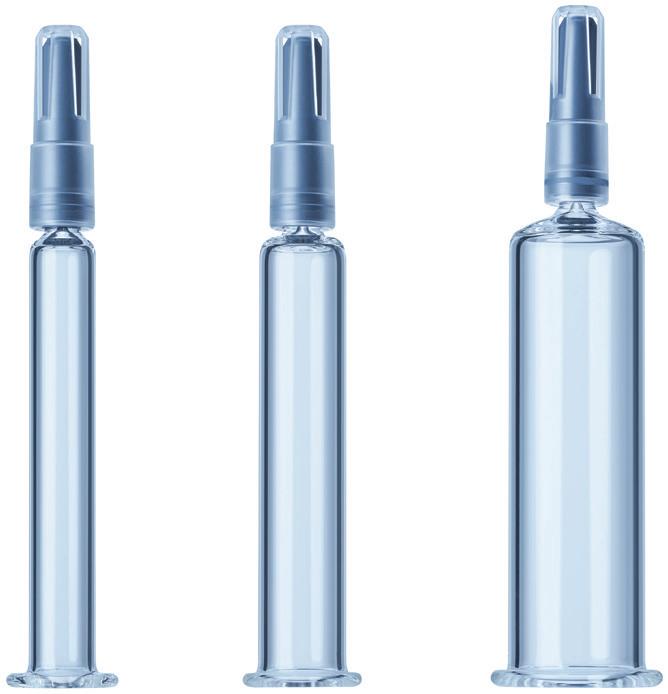

“When
a pharma customer is considering final assembly, Ypsomed is at hand to make recommendations and facilitate the selection of manufacturer based on its established global network of fill-finish and final assembly CDMOs.”
solutions for both clinical and commercial supply based on clearly specified ready-toorder equipment. This extends to process aspects such as functional release testing, labelling and final packaging.
When a pharma customer is considering final assembly, Ypsomed is on hand to make recommendations and facilitate the selection of manufacturer based on
its established global network of fillfinish and final assembly CDMOs. For YpsoDose, Ypsomed not only collaborates with SCHOTT Pharma (Mainz, Germany) for the 10 mL cartridge, but also with ten23 health (Basel, Switzerland) to harness its formulation and process development, filling, assembly and testing of the final product.

Understanding the cartridge or prefilled syringe dimensions is important, but understanding the filling process and the filled container as a system are critical to completing successful ISO verification testing for each combination product. Ypsomed collaborates with sterile filling equipment manufacturers to keep up to date with the latest filling process developments. Their equipment is used by both pharma’s in-house manufacturing and the global network of CDMOs that are involved in more than 50% of all pharma projects. With over 130 active customers, Ypsomed is a proactive and fully integrated player in the global pharma and CDMO manufacturing network.
Whether pharma customers are looking to establish contacts within the global drug-device consulting network or to source trainer devices or other specialist know-how, Ypsomed is always available to make recommendations from its extensive partner network.
Drug-device development and manufacturing is complex and more demanding than simply understanding the device itself. Ypsomed has been at the heart of the combination product ecosystem for over 40 years. The company’s comprehensive pen injector and autoinjector platform
portfolio, including UnoPen and YpsoMate (Figure 5), and its partner network are ideally positioned to support the rapidly increasing demand for self-injection devices.
Ypsomed’s comprehensive self-injection device platforms consist of autoinjectors for prefilled syringes in 1 mL, 2.25 mL and 5.5 mL formats, disposable pens for 3 mL and 1.5 mL cartridges, reusable pen injectors and ready-to-use prefilled patch injectors for up to 10 mL volumes.
Since 1984, Ypsomed has focused on the development and manufacture of innovative injection systems. Ypsomed is well equipped to tackle digital healthcare challenges and has invested strategically in the development of connected solutions and therapy-agnostic digital device management services. Anticipating the future needs of patients, pharmaceutical
customers, payers and healthcare professionals, Ypsomed has moved beyond manufacturing connected sensors. Ypsomed’s smart device solutions strive to transform patients’ lives by capturing therapy-relevant parameters, processing them to facilitate self-management of chronic diseases and integrating these insights with third-party digital ecosystems. The company leverages its in-house capabilities in mechanics, electronics, software and connectivity for the development of new devices and digital product systems. Ypsomed is ISO 13485 certified and all its processes comply with design control and cGMP guidelines, with operational QA/QC experts on site at each location. Ypsomed’s US FDAregistered manufacturing facilities are regularly inspected by pharma customers and regulatory agencies and supply devices for global markets including the US, Europe, Japan, China and India.
Ian Thompson, Vice-President Account & Business Development, has been with Ypsomed, formerly Disetronic, since 1995 in a number of roles in key account management and business development, working with pharma companies to develop innovative self-injection systems and bring them to market. He studied biochemistry and biotechnology in the UK, working initially in commercial roles in fermentation technology. He has worked in medical device companies since moving to Switzerland in 1990. Since 2003, Mr Thompson’s main focus has been business development and new product innovation, leading to the successful development and launch of a range of new pen injector, autoinjector and patch injector customisable platform products for Ypsomed Delivery Systems.
Broadest portfolio of self-injection products built on platforms
Serving pharma globally for all their originator and biosimilar needs
Over 70 products launched in 15 different therapeutic areas
Global manufacturing footprint spanning Switzerland, Germany, China and North America
Fully integrated strategic partner network






In this article, Sebastien Cordier, Technical Product Manager, Benjamin Brocco, PhD, Marketing Manager, and Audrey Chardonnet, Business Development Director, all at Aptar Pharma, and Edgar Bauer, Regional Sales and Business Development Director Europe at Bausch+Ströbel, discuss the results of tests on the performance of PremiumCoat® syringe plungers on high-speed fill-finish operations with vented insertion.
Injectables are the second most common administration route for medicines – and overwhelmingly dominant in vaccine and biologics delivery. However, the development and commercialisation journey are complex and require drug developers to consider a wide range of factors to ensure that the drug is efficient, stable over time and can be taken from the bench to commercial manufacturing scale. Among these factors, the choice of primary container system is vital, as the drug is in direct contact with both the container itself and the rubber closure component.
Over the past decade, drug developers have been striving to deliver improved outcomes for patients while also addressing previously unmet therapeutic needs, which has been made possible with the normalisation of biologic drug technologies such as monoclonal antibodies, recombinant proteins and nucleic acids. However, the
“Besides ensuring their drug remains safe at all times, pharma manufacturers must ensure that their choice of components and container is compatible with their operation.”
nature of these large molecules makes them highly sensitive and consequently increases the uncertainties associated with their development, which pushes pharma companies to adopt risk-mitigation strategies.
Closure component developers have been collaborating with pharma companies to support biologic development and have introduced film-coated rubber solutions for vials and prefilled syringes (PFSs). Aptar Pharma’s PremiumCoat® solutions combine a state-of-the-art bromobutyl formulation with a market-proven ethylene tetrafluoroethylene (ETFE) film that is positioned at the drug/rubber interface, where it acts as a barrier that limits the transfer of extractables and leachables (E&L) into the drug product.1 The PremiumCoat® platform includes vial stoppers (13 mm and 20 mm formats), syringe plungers (1 mL* and 1–3 mL formats), a wealth of supporting data and a broad range of services to ensure that drugs remain stable and safe throughout filling, storage2 and patient administration.
Besides ensuring their drug remains safe at all times, pharma manufacturers must ensure that their choice of components and container is compatible with their operation, whether it is for vial or PFS filling. For PFS plungers, this machinability encompasses all the steps, from the movement of the components into the vibrating bowl to their travel through the railings and final insertion into the syringe barrel, using either
Sebastien Cordier
Technical Product Manager
T: +33 6 3170 5278
E: sebastien.cordier@aptar.com
Dr Benjamin Brocco
Marketing Manager
T: +33 6 7404 8924
E: benjamin.brocco@aptar.com
Audrey Chardonnet
Business Development Director T: +33 6 8015 6217
E: audrey.chardonnet@aptar.com
Aptar Pharma 10 Rue Louis Blériot 92500 Rueil-Malmaison France
www.aptar.com
Edgar Bauer
Regional Sales and Business Development Director Europe
T: +49 7904 701 295
E: edgar.bauer@bausch-stroebel.de
Bausch + Ströbel SE + Co KG Parkstraße 1 74532 Ilshofen Germany
www.bausch-stroebel.com

“The plungers demonstrated optimal machinability in the vibrating bowls and through the distribution system.”
vent-tube or vacuum insertion. When it comes to syringe components, drug fillers reported that, after vent-tube insertion, a market reference for ETFE-film-coated plungers displayed film damage, such as tears or ripples, which had the potential to impair the barrier effect of the film.
The compatibility of PremiumCoat® syringe plungers with both vent-tube and vacuum insertion methods has been previously demonstrated, showing that all three ribs of the plungers come into contact with the glass barrel to ensure container closure integrity while enabling easy drug delivery.3 To reinforce understanding of machinability, Aptar Pharma collaborated with Bausch + Ströbel (B+S), which performed a series of tests to further assess the compatibility of the PremiumCoat® 1–3 mL plunger with its widely used high-speed filling lines, without requiring equipment change.
In this study, the plungers demonstrated optimal machinability in the vibrating bowls and through the distribution system. They could be inserted into the syringe
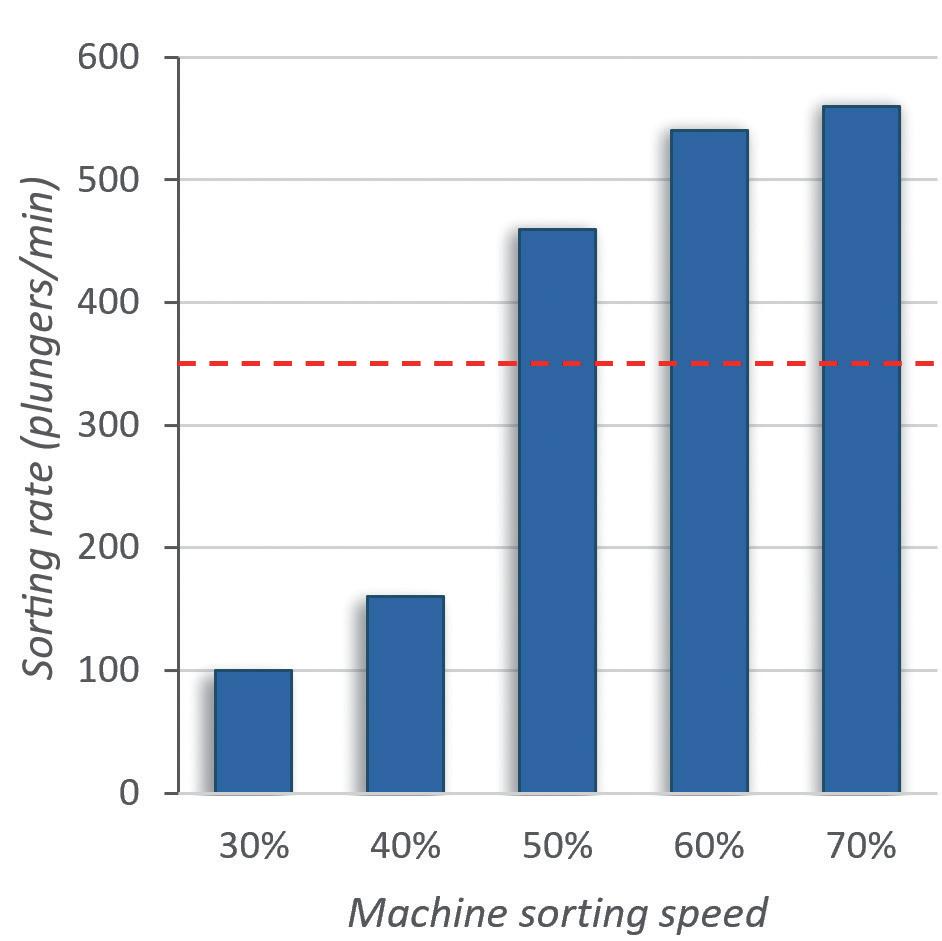
barrels using the vented method without requiring excessive force, while also limiting the temperature increase of the vent tube, which is a known particle generation factor on such filling lines. Taken together, these data confirm that PremiumCoat® is ideally suited to enable high-speed fill-finish operations while preserving the integrity of the drug, making it an ideal solution for new drug development, as well as second- sourcing projects.
All subsequent tests were conducted on Aptar Pharma’s PremiumCoat® 1–3 mL syringe plunger, processed on an SFM5110 fill-finish machine that B+S equipped with a sorting bowl, selection and orientation devices, feed tracks and vent-tube insertion. The cycle time was set at 960 ms – the required cycle time to process syringes at a maximum capacity on all syringe filling and stoppering machines by B+S.
PremiumCoat® 1–3 mL Syringe Plungers Reach the Target Sorting Rate from 50% Machine Sorting Speed
The first step of the filling operation takes place when an operator feeds the sorting bowl with the plungers. The vibration of the bowl delivers the plungers into the feed tracks, passing through the plunger gates to ensure that all plungers are oriented appropriately.
To evaluate the machinability of the PremiumCoat® 1–3 mL syringe plunger on the sorting steps, the plungers were placed in the vibrating bowl and the vibrating bowl tested at sorting speeds from 30% to 70%. The number of plungers processed per minute was recorded at every 10% increment of sorting speed and the target rate of sorting defined at 350 plungers/min for a five-headed filling machine.
Figure 1 shows that, at 30% sorting speed, about 100 plungers are processed every minute. Although an increase of the sorting speed to 40% increased the sorting rate by 60%, the subsequent increase to 50% sorting speed multiplied the sorting rate by a factor of 2.8 to reach 480 plungers/min, well above the target sorting rate of 350 plungers/min. The sorting rate continued to increase proportionally to the sorting speed, to reach a value of 560 plungers/min at 70% speed.
“During all operation, no issue was observed; the plungers' distribution, feed track and plunger gates worked as intended with the stoppers.”
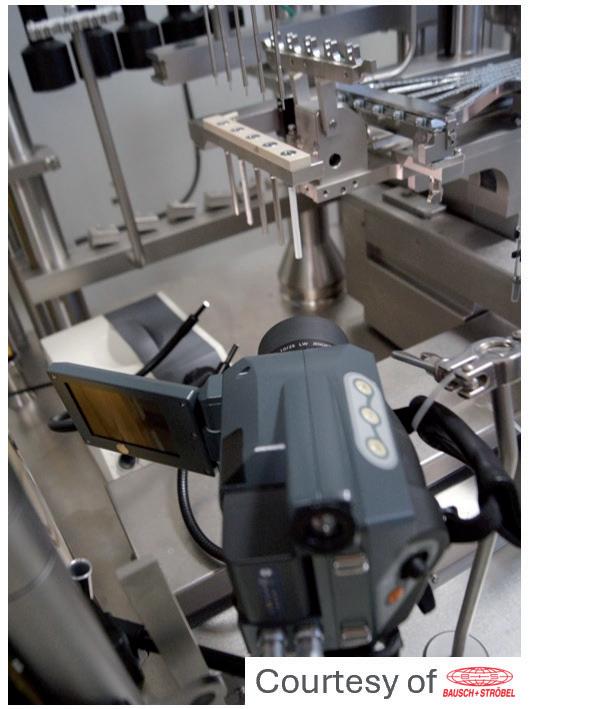

Figure 2: Measurement of the vent tube temperature during insertion cycles. A: Experimental set-up. B: Temperature of the vent tube measured throughout 50 successive insertion cycles. Two insertion depth settings were tested. The 10 mm insertion depth is associated with a faster insertion of the stopper than the 50 mm. The maximum acceptable temperature was defined at 60°C.
During all operation, no issue was observed; the plungers' distribution, feed track and plunger gates worked as intended with the plungers. No plunger got stuck in the sorting bowl. These results indicate that the design of the PremiumCoat® 1–3 mL plunger and its physical properties enable easy machinability and high efficiency on filling lines, even when operating at 50% sorting speed with the machine used.
PremiumCoat® Did Not Cause Abnormal Heating of the Vent Tube During Filling Operations
Once the plungers have been distributed into the tracks, they are delivered to the vent tube for insertion into the syringe barrel. In principle, the plunger is forced through the vent tube, which has a smaller diameter than the plunger and the syringe barrel. Consequently, the plunger undergoes deformation and the friction between the plunger and the vent tube's inner surface leads to an increase in temperature. An abnormal increase of the vent-tube temperature, beyond 60°C, could lead to the generation of rubber particles and jeopardise fill-finish operations.
The plungers were processed by the vent-tube insertion method at a 10 mm or 50 mm insertion depth – the 10 mm insertion depth being associated with a faster travel of the plunger through the vent tube. The temperature of the vent tube was tracked for 50 insertion cycles, over 60 seconds, using a high-resolution thermographic camera (Figure 2A).
The results in Figure 2B show that, after 30–40 cycles of vented insertion
“These data demonstrate that PremiumCoat® plungers are well adapted for vent-tube insertion and that they are unlikely to generate particulate contamination on a fill-finish line.”
of PremiumCoat® 1–3 mL plungers, the temperature of the vent tube stabilised at 40°C and 45°C. The results are similar for both insertion depth and in every situation the temperature remained well below the maximum acceptable threshold of 60°C. The higher temperature reached for the 10 mm insertion depth can be explained by the fact that the travel speed of the plunger is faster, which would generate increased friction.
These data demonstrate that PremiumCoat® plungers are well adapted for vent-tube insertion and that they are unlikely to generate particulate contamination on a fill-finish line.
The Force Required to Pass PremiumCoat® 1–3 mL Plungers Through the Vent Tube During Insertion Is Well Within Machine Capability
The temperature increase observed during vented insertion is a direct consequence of friction between the rubber plungers and the vent tube. Although the results shown in Figure 2 seem to indicate minimal friction occurs, a complementary test was performed to directly measure the force required to insert PremiumCoat® plungers into syringe barrels using the vented method.
A force sensor was connected to the vent-tube insertion stem (Figure 3A) and the force was measured during a series of insertion cycles performed at 10%, 20%, 50% and 100% speed. The maximum acceptable insertion force was defined at 80 N.
The data shown in Figure 3B show that the force measured during insertion is directly correlated to the insertion speed, as could be expected. Most importantly, even when operating at 100%, the force required to insert PremiumCoat® plungers into the vent tube does not exceed 40 N, which is well below the defined limit of 80 N.
Choosing the right primary packaging can be a daunting task, as issues could be encountered as early as during compatibility testing, but also much later in the development and industrialisation process. The consequence of identifying processability issues when upscaling production to industrialisation can be costly and may require restarting the validation process with an alternative packaging solution.
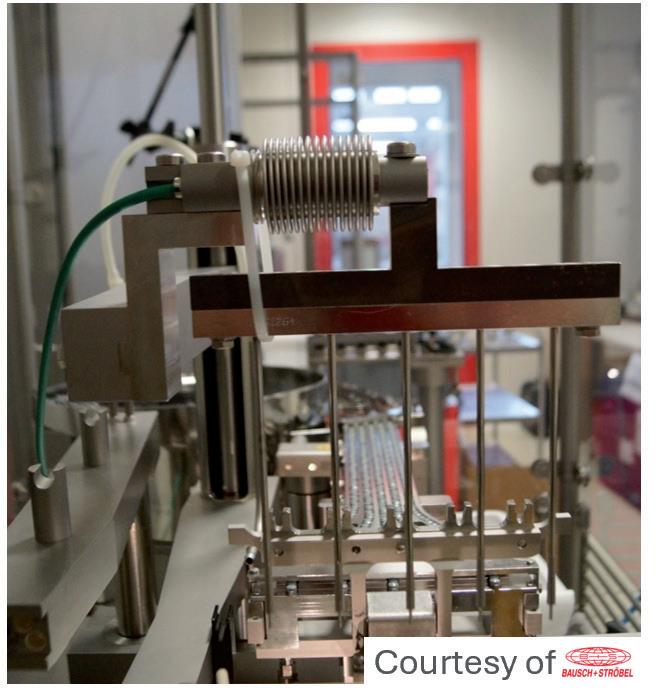
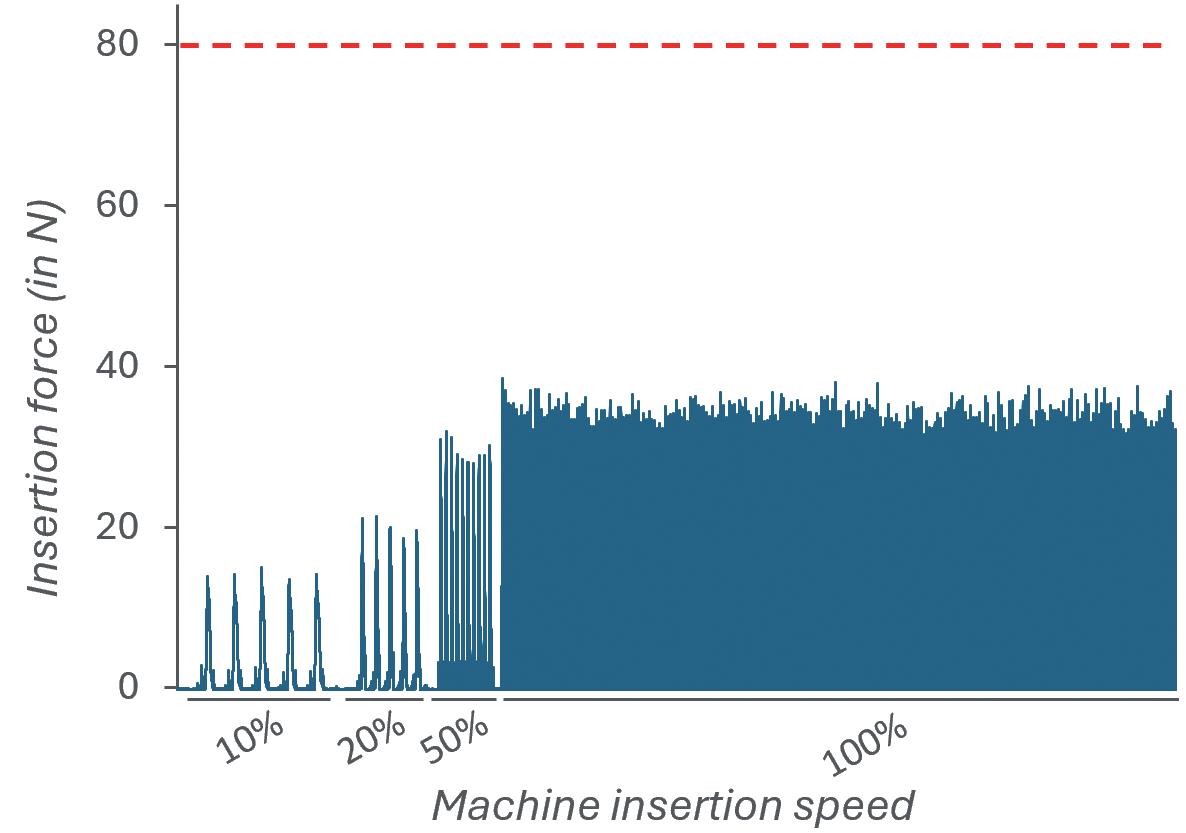
Figure 3: Measurement of the force during vented insertion of PremiumCoat® 1–3 mL plungers. A: Experimental set-up, with the force sensor positioned at the insertion stem. B: Insertion force measured at 10%, 20%, 50% and 100% insertion speed. The maximum acceptable insertion force was defined at 80 N.
“The consequence of identifying processability issues when upscaling production to industrialisation can be costly and may require restarting the validation process with an alternative packaging solution.”
PremiumCoat® solutions have previously been proven to help protect drugs from E&L,1 maintain long-term container closure integrity down to -60°C for PFSs4 and -80°C for vials,2 enable autoinjector integration and facilitate drug delivery.3 This dataset completes the picture by demonstrating that PremiumCoat® plungers also perform well on all relevant parameters associated with high-speed fill-finish operations using vented insertion, helping drug manufacturers secure industrialisation for drugs and derisk drug development.
In addition to the data supporting the performance of PremiumCoat® on various parameters, Aptar Pharma and Gateway Analytical (PA, US) offer a wide range of cGMP-compliant development and analytical services to help drug developers reach market faster. Additionally, because the success of a drug does not stop at drug filling, Noble’s (FL, US) complete range of human factors, user experience, training and onboarding
solutions helps drug developers to ensure that their drug gets delivered appropriately and guarantee the best outcome for patients.
*Available from BD
Aptar Pharma provides innovative drug delivery systems, components and active material solutions across a wide range of delivery routes, including nasal, pulmonary, ophthalmic, dermal and injectable. Aptar Pharma Services provides early-stage to commercialisation support to accelerate and derisk the drug development journey. With a strong focus on innovation, Aptar Digital Health is developing digital healthcare devices to help improve patient adherence and compliance. With a global manufacturing footprint of 14 manufacturing sites, Aptar Pharma provides security of supply and local support to customers. Aptar Pharma is part of AptarGroup, Inc.
Bausch + Ströbel is an experienced supplier to the pharmaceutical industry, specialising in filling and packaging systems. Its filling and packaging lines are used worldwide to fill syringes, vials, cartridges and ampoules with high-grade liquid and powder pharmaceutical products. Applications range from cleaning and sterilisation to labelling and syringe assembly. In addition to designing and building systems tailored to customer specifications, Bausch + Ströbel provides a wide range of specialised services aimed at ensuring system reliability and productivity.
1. Suman J, Cordier S, Verger E, “Combining a State-of-the-Art Bromobutyl Formulation With a Proven ETFE Film for Exceptional Chemical Performance”. Drug Development & Delivery, Jan/Feb 2022, Vol 22(1), pp 34–38.
2. “Cold storage and container closure integrity – demonstrated performances of ETFE-Coated components”. ONdrugDelivery, Issue 147 (May 2023), pp 6–11.
3. Cordier S, Guillemot L-H, Cardonnet A, “Exploring How the Functional Properties of the PremiumCoat® 1-3mL Plunger Facilitate its Implementation on Filling Lines & Enable the Delivery of Sensitive Vaccines & Biotech Drugs”. Drug Development & Delivery, Oct 2021, Vol 21(7), pp 34–39.
4. “Evaluating syringe plunger functional performance to secure Pre-Filled Syringe & Auto-Injector integration and machinability on filling lines: PremiumCoat® 1-3 mL syringe plunger”. Poster Presentation, Aptar Pharma, PDA Universe of Pre-Filled Syringes and Injection Devices, Gothenburg, 2023.



Sébastien Cordier is Technical Product Manager at Aptar Pharma’s Injectables division. A graduate of MINES ParisTech and EDHEC Business School in France, he spent more than 15 years in the automotive industry, where he developed strong expertise in plastics and elastomers, before joining Aptar Pharma in 2020. In his current role, Mr Cordier is responsible for the PFS platform, which includes PremiumCoat® syringe plungers, and is dedicated to supporting customer development projects with coated elastomeric solutions.
Benjamin Brocco , PhD, is the Marketing Manager for Aptar Pharma’s Injectables division. Dr Brocco holds a PhD in Biophysics, is a graduate of Grenoble Ecole de Management and has worked at a world-leading delivery device company, where he developed an in-depth understanding of the needs of injectables drug developers. He joined Aptar Pharma in 2020 to co-ordinate the company's global marketing operation for its Injectables division and subsequently expanded into Scientific Affairs to develop Aptar Pharma’s leadership in scientific and technical communication on the drug delivery market.

Audrey Chardonnet is the Global Business Development Director for PFS components at Aptar Pharma’s Injectables division and is responsible for driving the strategy for the company's PFS segments. She previously held various positions within the Aptar Pharma sales organisation, most recently as Director, Global Strategic Customers, with a particular focus on business development with syringe manufacturers and global accounts. Ms Chardonnet graduated with a master’s degree in Chemistry and has over 15 years of experience in the injectables industry.

Edgar Bauer has held various technical and commercial positions at Bausch + Ströbel since 1989, gaining a thorough knowledge of the requirements of the pharmaceutical industry. His current role is Regional Sales and Business Development Director Europe and Global Key Account Manager. Together with his team, he is responsible for sales to European countries and the support of international key accounts.

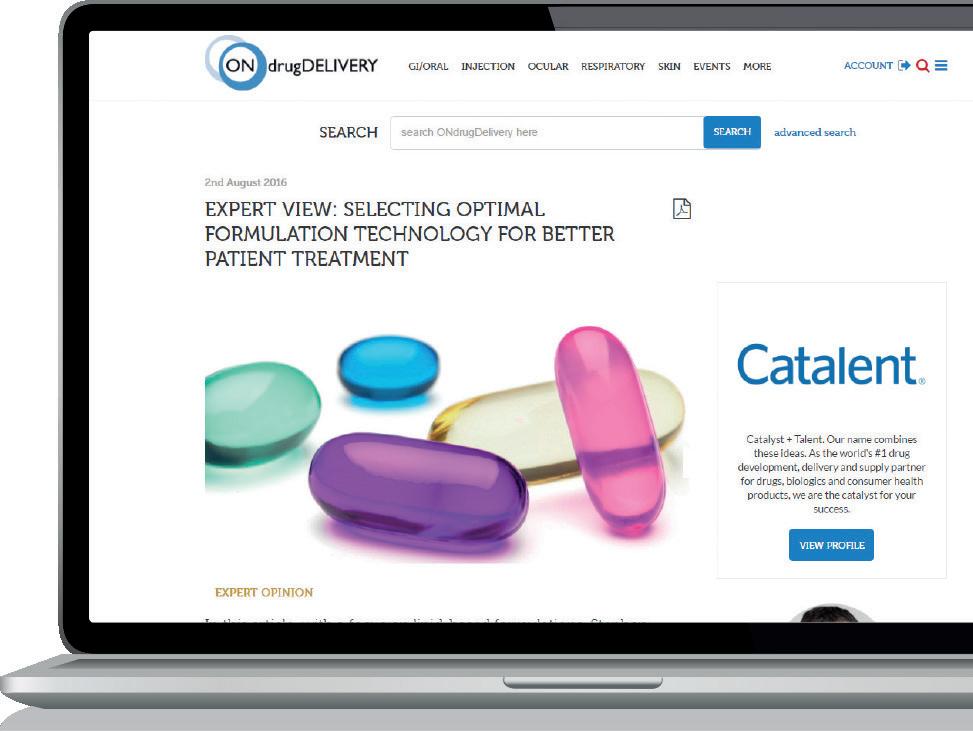



Big health challenges require transformative thinking. At Aptar Pharma, we’re transforming expectations of what an injectables partner can be.
To meet increasing demand and expectations for drug/container compatibility, we’re expanding our manufacturing footprint to deliver billions of additional injectable components each year, including 1 billion PremiumCoat® ETFE film-coated solutions. We’ve already implemented advanced robotics and added new clean rooms to enhance quality and derisk your sensitive drug development.
With our increased capacity and agility, together we can meet the world’s biggest health challenges, today and tomorrow. Join us.

Shaping the future of injectables, together visit www.aptar.com/pharmaceutical
In this Expert View, Dave Beckstoffer, Business Development Manager at Portescap, explains the importance of material selection in drive system development, the key attributes of materials towards a wearable and auto-delivery device, and discusses the need to achieve industrialisation based on material selection and relevant manufacturing processes.
Drive systems for wearable and automatic drug delivery devices are central to patient outcomes. Key to ensuring the value of these devices is materials specification, which helps to achieve critical factors such as delivery precision, device reliability and light weight for comfortable use. Material selection also significantly impacts the industrialisation of the drive system. Whether or not the design can achieve the right performance, at the right cost point, means a focus on material selection is essential throughout a development project.
“In line with increasing demand from the pharmaceutical market to deliver biologics from wearable devices, demand is increasing on the drive systems that power drug delivery.”
commercial viability. This means turning an effective concept into an industrialised product, from a computer assisted design (CAD) drawing and prototype through to manufacturing scale (Figures 1 and 2).
In line with increasing demand from the pharmaceutical market to deliver biologics from wearable devices, demand is increasing on the drive systems that power these drug delivery devices. While ensuring that the drive systems achieve essential requirements relating to treatment efficacy, patient safety and wearer comfort, the design must also optimise
Crucial to achieving a commercially viable, industrial-scale production drive system is material selection, and the implications of the types of material used are far reaching. The selection impacts the performance of the device from the patient perspective, where competing design needs must be balanced. The material specification also depends on meeting medical device conformance, as well as ensuring effective integration with the actuation mechanism.


Dave Beckstoffer
Business Development Manager
T: +1 540 230 9300
E: dave.beckstoffer@regalrexnord.com
Portescap
110 Westtown Road
West Chester PA 19382
United States
www.portescap.com

To optimise commercial viability, these material requirements must be carefully balanced to minimise cost. However, the materials used in the early stages of development, including prototyping, can differ significantly to those necessary for a final, production-ready design. Every iteration impacts the next, so this process must be carefully managed, avoiding deviations in material selection that can affect the delivery of the overall project, including the ability to efficiently industrialise a design. As a result, a guiding theme in drive system development is to focus on material selection at the earliest opportunity and maintain this focus throughout.
“The drive system must ensure reliability, informed by the required volume of delivery cycles and lifetime of the device.”
Each drive and delivery system has its own requirements relating to factors such as drug viscosity and method of delivery, so the design is typically customised. An overriding factor across all wearable devices and autoinjectors is the need for a compact form with low weight to achieve patient ergonomic requirements. Direct current (DC) micro-motors are typically optimal for these characteristics, such as having a diameter as small as just 10 mm. However, the gearbox is often the larger component, especially when the design has an integrated output drive mechanism, such as a lead screw or a pump. As a result, the gear system and drive mechanism present the typical opportunity for customisation, and this includes material selection too (Figure 3).
In addition to size and weight requirements, the fundamental design needs, supported by material choice, include the efficacy and safety of drug delivery. This means that the drive system must ensure reliability, informed by the required volume of delivery cycles and lifetime of the device. Here, material choice is integral.

For example, plastic, such as polyphenylene sulphide or polyamide, may be a suitable material for use up to 100 hours, while applications with higher physical demands and lifetimes up to 3,000 hours would need a more durable material. Metal, such as stainless steel, aluminium or brass, is typically used in these instances. Dealing with day-to-day use, the delivery system must also be able to withstand accidental drops and impacts.
Efficacy and safety of treatment also depend on accuracy of delivery – here, too, materials are an important consideration. For continual 24/7 administration, moulded
plastic components might be sufficient, whereas, for infrequent, low-volume dosing, metal machined drive components might be necessary to achieve accuracy ±0.5%.
Keeping the patient at the forefront of the design also means that the device requires an efficient system that minimises energy use, enabling a smaller and lighter battery system. The device should also minimise audible noise – the longer the lifecycle, the more important this is. While metal gears are typically more efficient, achieving lower friction losses, plastic gears are usually quieter, with reduced audible output during meshing.
Material demands can also impact conformance requirements, from common needs such as Restriction of Hazardous Substances (RoHS), Registration, Evaluation and Authorisation of Chemicals (REACh) and Conflict Minerals, through to meeting manufacturing regulations such as ISO 13485 (Quality Management System for Medical Devices) and IEC 60601 (Medical Electrical Equipment Safety Standards).
To optimise the industrialisation of a design, balancing the required criteria will help to guide material selection from a cost perspective. However, this does not just relate to the value of the raw materials but also includes the cost of the manufacturing process.
Designing the drive and delivery mechanism to achieve the best outcome for the patient, which includes specifying the ideal materials, is the right starting principle. However, the need to develop certain elements of the design sequentially to varying schedules means that the materials used at each phase will also likely change as the project progresses (Figure 4).
In real-world development, a drug delivery design contractor, or the motion developer, needs to prove the concept to the pharmaceutical company. This stage will take place within a specific, and relatively short, timescale; the quicker it can be done, the faster the delivery device can be brought to market. To achieve this, initial decisions around material selection and part design are often made based on speed and availability, rather than optimising for longer-term design objectives.

“In real-world development, a drug delivery design contractor, or the motion developer, needs to prove the concept to the pharmaceutical company.”
Off-the-shelf drive system designs might be used to confirm general requirements. From the start, this means that there can be a discrepancy between the materials involved in a conceptual test compared with those ultimately required for an industrialised product.
At this stage, 3D-printed parts are commonly introduced, with their short lead times being a key advantage for the development of a low-volume parts run. While it is possible to prototype a drive and delivery system in a metal 3D print, commonly, plastic 3D printing is used because of its advantages in simplicity, speed and cost. While there will be limitations in the tolerances of 3D printed parts, material testing will not be a factor at this stage.
However, the key consideration during the concept phase, as well as throughout the feasibility stage of development, is that it is important to make decisions regarding
materials and designs that can be carried forwards into industrialisation. This means that, at the project’s culmination, the desired material qualities can be achieved at high manufacturing scale and at the forecasted cost point. If not, the deviation in material choice between design iterations can become restrictive towards meeting the final specification.
This challenge may only be realised, as late as the validation and verification stage, where the design is nearly set for confirmation. At this stage, a resolution will require either a rework of previous design steps, adding time and cost to the project overall while the design and materials are revised, or it will mean that the final design objectives are unable to be met.
The design process is complex, and there are a multitude of reasons why it may reach an industrialisation pivot
point, which occurs when a part that is effective from a performance perspective fails to be commercially viable because of manufacturing capabilities or cost. Either the final part becomes prohibitively expensive to manufacture in the desired material, or the specified material does not meet the intended tolerance.
For precision, machined metal parts may prove the concept, but they may not be viable for the industrialisation of all drug delivery devices. Alternatively, plastic moulding can deliver high volume, economical manufacture, but it might not deliver the required tolerance if accuracy is vital.
A key point of friction during device development is design and material changes to components in the drive and delivery system that are made in isolation. From using metal components that could react to the motor’s magnets, to the decision on whether or not to use plastic or metal parts in gearing and how this might integrate with the delivery system, material selections must be made in conjunction with each other. Similarly, commercial demands introduced
during ongoing development could ask for a cost reduction – or for a shorter timeframe – on the procurement of specific parts. This should be met with a thorough examination of how this would impact material specifications, including the subsequent impact on other system components.
“At every stage of development, keeping a focus on the materials used is crucial.”
Ultimately, the only way to fully validate material selection for a given design is by testing products from the manufacturing run. Of course, in reality, this is too late, so the most effective means of achieving the right material specification is through the decisions that are made earlier on in the project.
At every stage of development, keeping a focus on the materials used is crucial. Supporting this, communication throughout all stages – between the pharmaceutical company, device design contractor, drive system developer and material suppliers –is also key. The more that the various aspects of the design process, including materials specification, are considered
in parallel, the more efficient the entire process will be in achieving the optimised industrialisation of the drive system.
Portescap, part of Regal Rexnord, offers a broad range of miniature and specialty motor products, including coreless brush DC, brushless DC, stepper can stack, gearheads, digital linear actuators and disc magnet technologies. Its products have served diverse motion control needs in a wide spectrum of applications for more than 70 years, including medical, life sciences, instrumentation, automation, aerospace and commercial.
Dave Beckstoffer, Business Development Manager in the medical team at Portescap, has over 31 years of experience in the motion control industry. He brings a customer-focused mindset to every application, understanding the link between the end product features and the motion system design. Mr Beckstoffer leads the development of drive mechanisms tailored for the specific requirements of infusion systems, marrying motor, gearing and feedback technologies with multiple drug delivery methodologies to achieve the optimum design for each device.





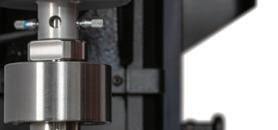
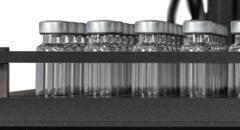
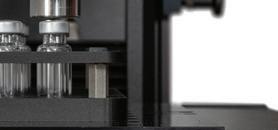































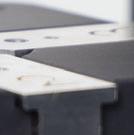


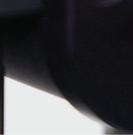















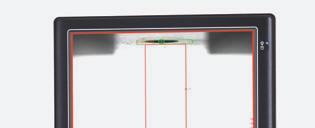






In this article, Colby Chen, Senior Mechanical Engineer and Team Leader, and Ian Chang, Senior Control Engineer and Team Leader, both at SHL Medical’s Automation Systems Department, discuss how the introduction of modularity can close the gap in traditional assembly systems to enable fully automated, high-quality autoinjector assembly in support of low-volume/high-mix manufacturing.
In the modern pharmaceutical landscape, the scope and speed of drug development have grown tremendously, resulting in more products being developed and launched across both large and emerging markets. Pharmaceutical companies continuously strive to expedite market entry and often face the need to scale production within stringent timelines corresponding to the preclinical, clinical and commercial phases, however, the race does not stop there. Depending on the postlaunch success of the combination product, among other factors, such as potential expansion into new therapeutic applications and new markets, pharmaceutical companies may need to rapidly adjust production scales and implement additional marketing strategies. These strategies could include introducing the same molecule under a region-specific brand or expanding the product label to ensure sustained market access and profitability.
These factors not only affect pharmaceutical companies but also impact the entire pharmaceutical value chain,
“The adoption of automated technologies to assemble medical devices such as autoinjectors and pen injectors is not a new concept.”
including drug, container, device and packaging manufacturers and suppliers. Equipment suppliers, often at the end of the value chain, are being challenged to enhance their equipment’s agility to meet project and manufacturing flexibility requirements while keeping production streamlined without compromising quality and efficiency, particularly for high-mix/ low-volume manufacturing.
The adoption of automated technologies to assemble medical devices such as autoinjectors and pen injectors is not a new concept. SHL’s records show that its first semi-automated, machine-assisted assembly machine was developed as early as 2001 for the assembly of a prefilled pen for the treatment of hepatitis C. A review of the supplier landscape also reveals a plethora of assembly machines and solutions for medical device sub-assembly and final assembly. However, a closer look at current market solutions indicates that low-to-medium volume manufacturing has primarily been limited to machine-assisted manual assembly or semiautomated assembly systems, both of which are highly reliant on operators (Table 1). This limitation stems from the relative speed and lower financial thresholds needed to implement these technologies to meet the fluctuating demands of the pharmaceutical industry. Conversely, while fully automated assembly systems offer enhanced productivity, consistency and efficiency, they have

Colby Chen
Senior Mechanical Engineer and Team Leader
E: colby.chen@shl-medical.com

Ian Chang Senior Control Engineer and Team Leader E: ian.chang@shl-medical.com
SHL Medical AG Gubelstrasse 22 6302 Zug Switzerland
www.shl-medical.com
Pros

• Cost effective for smaller batches
• Shorter development lead time
• Relatively easy to adapt for multi-device compatibility
Cons
• Operator-dependent
• Possible variation from manual processes
historically been confined to large, complex projects due to their longer development timelines and higher initial costs.
With low-to-mid-volume manufacturing highly reliant on a company’s ability to recruit sufficient labour at reasonable costs, the traditional trade-off between full automation and operational flexibility presents new challenges for equipment providers. They must now develop fully automated assembly systems that incorporate production scalability, project flexibility and programme adaptability for smaller batch production.
To close this gap, SHL has developed the semi-modular automatic robot track (SMART), a fully automated, modular


• Compact solution for midvolume output
• Integrated quality controls
• Operator-dependent
• Limited flexibility for multidevice compatibility
assembly machine that combines the flexibility of manual assembly processes with the reliability of fully automated processes. Designed for mid-volume production, the SMART can reach an annual capacity of 7.5–10 million devices using at least two to three times less labour compared with manual assembly set-ups. It can also be adapted to assemble various devices, such as the Molly® 1.0 and 2.25 autoinjectors, on the same equipment.
Modularity in automation equipment is not a novel concept, and SHL has long been developing its automated testing
• Used for high-speed, high-volume output
• Integrated quality controls
• Operator-independent
• Higher initial investments
• Limited flexibility for multi-device compatibility
and assembly equipment with modular infrastructures. For example, SHL’s modular fully automated testing machine, introduced in 2019, was recognised for its innovation as a finalist in the 2022 CPHI Pharma Awards in the Manufacturing, Technology, and Equipment category.1,2 Designed as a fully automated alternative to manual assembly lines, the SMART’s innovation lies in its use of modularity to seamlessly converge physical components and modules with digital controls to enable versatile assembly operations and efficient project changeover. This is of particular importance as autoinjectors can comprise anywhere between one to several dozen components, each with vastly different
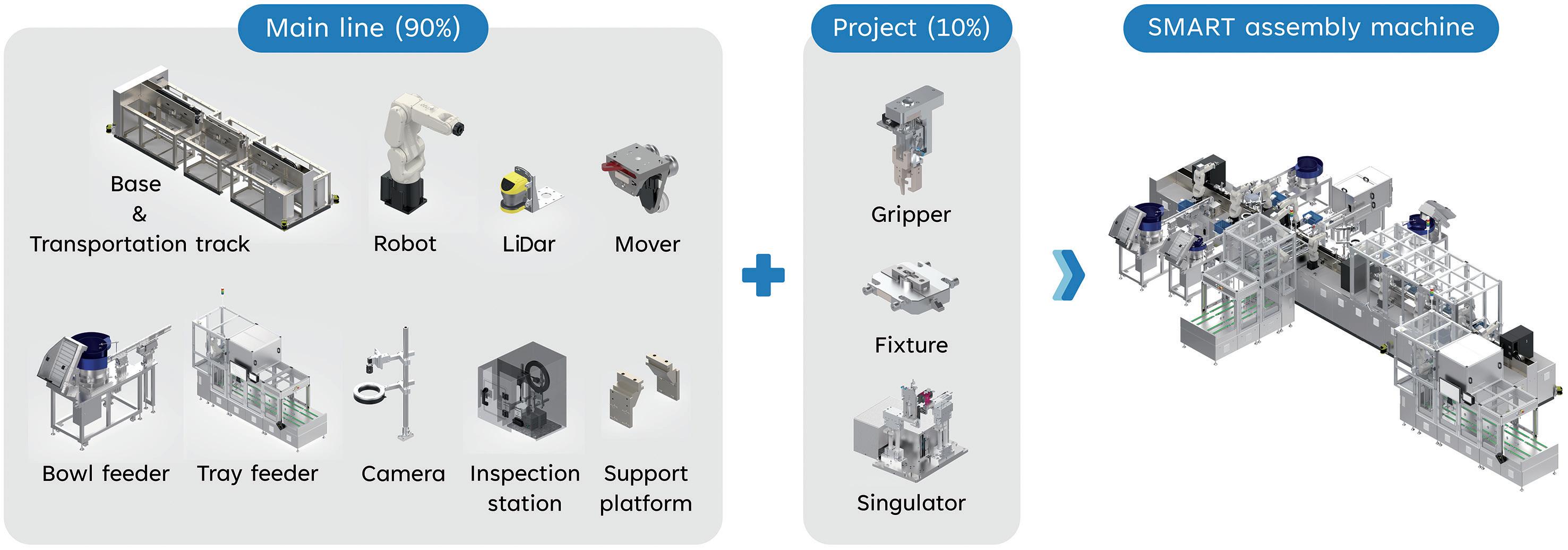
shapes and dimensions – a feature that has historically hindered the accommodation of greater versatility in fully automated autoinjector assembly machines.
The SMART features movable base frames with fully extendable linear tracks, housing robots on each side to create a modular station. Each station seamlessly integrates with a range of standardised material in- and out-feeding modules, such as tray feeders, bowl feeders, direct in-line spring feeders, and primary container tubs and rondo trays (Figure 1). These modules are designed for faster development, shorter engineering and site/factory acceptance test lead time, as well as quicker response and technical support. To enhance the SMART’s versatility and decrease downtime during project changes, it also features a patentpending Quick Tool Change interface that allows users to swiftly exchange project fixtures with the flip of a release handle.
In addition, the SMART’s modularity also aligns with SHL’s commitment to sustainability. Internal data looking at the quantity of listed parts show that up to 90% of the main machine structure can be reused when switching between different device projects (Figure 1). While the percentage of reusable modules may vary depending on the level of each project’s distinctiveness, reusing much of the machinery to assemble different devices may significantly reduce the environmental impact compared with producing and operating individual machines.
With the goal to maximise the SMART’s modularity, SHL took a step further in rethinking how modularity could enhance machine efficiency. During early development, the company assessed the necessity of each module and explored opportunities for combining functions. For example, modular units are usually designed based on two principles. The first considers the maximum variety of functions or configurations and combines them into a single modular unit. This overarching approach ensures that all the possible outcomes are considered and integrated into the design. Take the Swiss Army knife as an example. It combines multiple tools, such as blades, bottle openers, screwdrivers, even butane lighters, into a single multifunctional unit to cater for diverse needs. While Swiss Army knives come in various models, each in different sizes
Figure 2: Hand drawing of the original RSA fixtures design, which placed two fixtures on a single base.

and tool combinations, the core traits of versatility and functionality remain consistent thanks to its modular base design.
The second principle, in comparison, takes a granular look at each singular function to determine how different configurations can interconnect via a standardised or partially standardised interface. The most common example of this principle is the universal serial bus (USB) port. With a standardised physical interface, a range of electronic modules can seamlessly connect to one another to achieve different functions, such as data transfer, power supply and internet connection.
While seemingly disparate, the two principles are complementary in that, together, they enhance the robustness of the final product. This is because the first overarching principle ensures product versatility, while the second principle of granularity makes it possible to add new features or functions that were not considered at the outset of the design phase. By applying these two key principles, SHL thoroughly analysed and optimised each SMART module, both individually and collectively, resulting in innovative strategies that improved overall machine performance.
An example of innovative thinking beyond modularity lies in the SMART’s component transportation mechanism. During the assembly process for the rear sub-assembly (RSA), components are loaded onto a set of two fixtures (Figure 2) and transferred to different stations to complete the assembly sequence. Due to their features, some of these components require an additional module to guide or clamp them into
“An example of innovative thinking beyond modularity lies in the SMART’s component transportation mechanism.”
position and ensure correct alignment prior to assembly. To eliminate the need for an extra guiding/holding unit, the clamping mechanism was integrated directly into the moving shuttles. This enabled SHL to optimise the overall assembly time, which improved both machine cost and efficiency.
With the decision to integrate the functions, the challenge then arose of how to effectively activate the clamping without compromising the SMART’s transportation. The first step was to separate the two fixtures into shuttle pairs for better weight distribution between each mover. The next step was to activate the clamping movement, allowing the clamps on one shuttle to be triggered by the physical movement of the other. Initial iterations explored a spring-based mechanism, but rigorous proof of principle and failure mode and effects analysis activities led the company to develop an innovative solution: a combination of computer-controlled and mechanically actuated movement. In practical terms, as seen in Figure 3, the two shuttles are connected via a linkage component. When Shuttle B moves towards or away from Shuttle A, it triggers the clamps to release or clamp, respectively. The movements are fully controlled by the computerised system to ensure optimal control and reliability of every movement.

With the shuttle pairs connected, the third and final step was to ensure that they could move flexibly along the vertical circular track by automatically separating when they travel into the curve. While moving through the beginning of the curve, the first mover naturally tilts, creating a height deviation that results in the automatic separation of the two shuttles. The linkage connects again when the shuttles move horizontally side by side. The patent application for this innovative shuttle-based carriage guide rail system has been published in Europe, the US and Japan.
The SMART’s maximisation of modularity is also demonstrated in its use of robot systems. Instead of the more prevalent three-axis, three-orientation pick-and-place units, six-axis robots are employed for both feeding and assembly activities. These robots stand out for their remarkable precision, flexibility and ability to adapt to diverse production requirements. Like the shuttles, the robots are affixed with grippers that can be easily changed for different projects. As articulated robots, they have multiple joints that allow for a wider reach, an advantage that was leveraged in combination with the use of safety light detection and ranging (LiDAR). By removing physical enclosures around the robots, more space is created for the robots to
“Having developed more than 1,400 sub-assembly and final assembly machines for various autoinjectors and pen injectors over the years, SHL understands the importance of speed and reliability when developing assembly systems for medical devices.”
stretch out, allowing them to carry out additional tasks, such as removing rejected parts in a more efficient manner. This not only results in better use of space compared with traditional feeding and unloading pick-and-place units, the reduction of physical enclosures also results in easier access for troubleshooting as well as less material use.
Having developed more than 1,400 sub-assembly, final assembly and final device testing machines for various autoinjectors and pen injectors over the years, SHL understands the importance of speed and reliability when developing assembly systems for medical devices, regardless of the level of automation. The modularity of SMART also extends to its software and data control system. In brief, control systems comprise a mix of electrical, mechanical and computer engineering aspects. Serving as the link between the physical
hardware and the digital software, control systems define how a machine part or module reaches the desired state and functions as intended.
Leveraging its extensive experience and wealth of assembly data, SHL has developed not just modular machine platforms, but also a modularised control system for all its latest sub-assembly and final assembly machines. Known as the SHL Control Library, the modular control system is a standardised, company-specific software development process based on the Packaging Machine Language (PackML) framework established by the Organization for Machine Automation and Control. As a robust standard that enables easier transfer and retrieval of consistent machine data, PackML makes machines more serviceable while facilitating greater reapplication of the software between different machines. It allows engineers to efficiently develop stable, project-specific programs that, at the same time, enhance usability for the end users.3
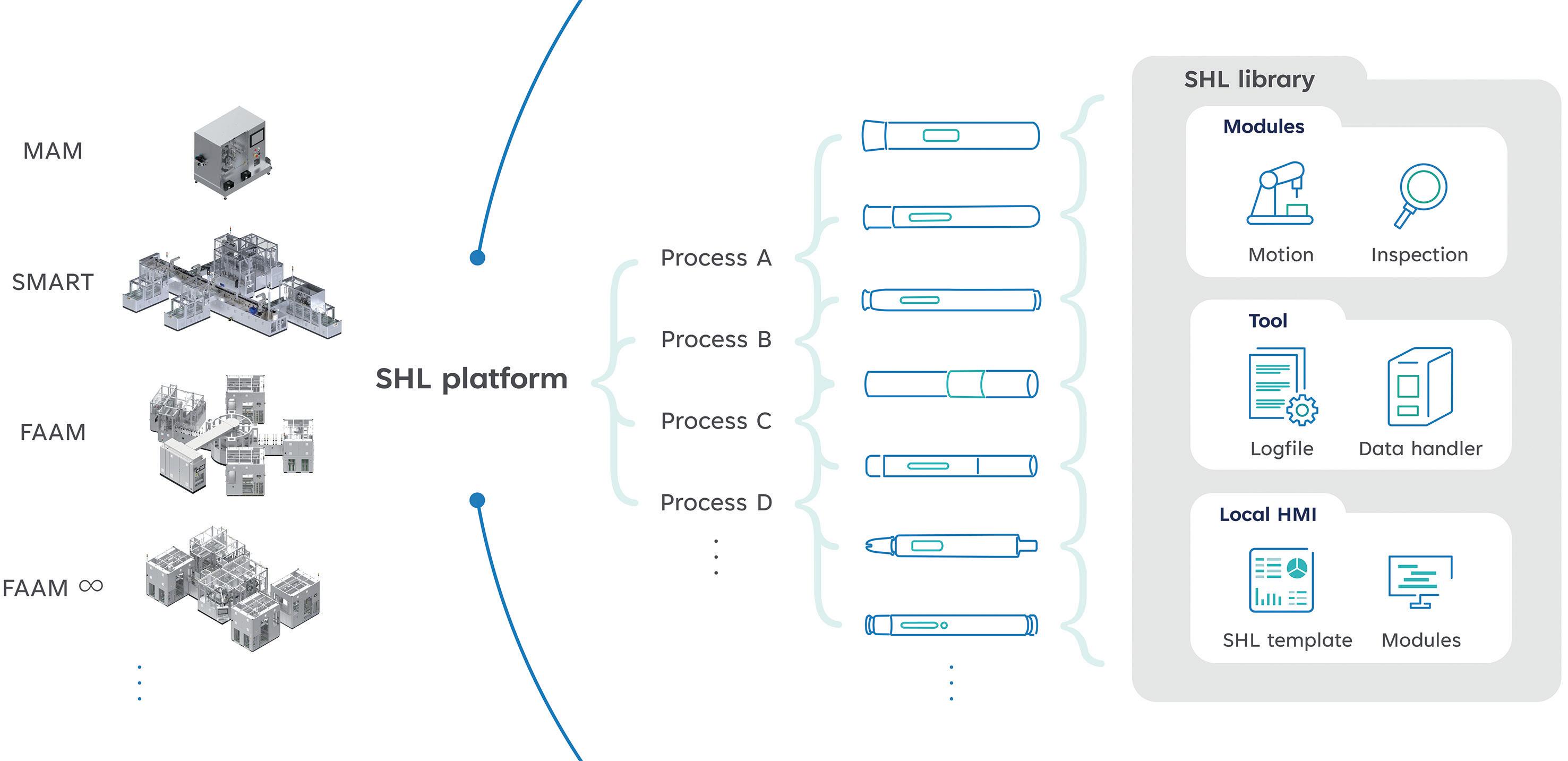
SHL’s Control Library encompasses a full spectrum of control modules covering the most common autoinjector sub-assembly and final assembly processes. The library consists of three main categories: modules, tools and human machine interface (HMI):
• Modules consist of commands for the physical modules related to the assembly machine, including robot arms, motors and inspection instruments
• Tools involves all non-physical execution components, such as data processing and file handling
• HMI consists of all functions used by end users to enable the rapid development of user-friendly software interfaces for different assembly projects.
With the modularised Control Library, a new SMART project can be developed and installed in relatively shorter timelines. For example, as illustrated in Figure 4, the main assembly processes (A–D) for autoinjectors are derived from the SHL Control Library. In practice, this means that when receiving the user requirement specifications for a new device project, the company can promptly assess the relevant assembly processes and develop the framework by integrating the predeveloped and validated functionalities from the library, deploying them into different machine systems. While there will still be project-specific processes that need independent defining, such as the exact
robot positioning, this modular approach facilitates faster development not just for implementing new device projects on the same SMART machine but also for migrating an existing device project from a SMART assembly machine to a highervolume, fully automated assembly machine platform, for example.
Another important benefit from using automation technologies for medical device assembly is the opportunity to integrate in-line quality measures to ensure the quality and repeatability of each manufactured product. While consistent production quality is essential in any manufacturing
“While consistent production quality is essential in any manufacturing process, it becomes particularly critical for self-injection devices as the final products are used by patients without direct supervision from healthcare professionals.”
process, it becomes especially critical for self-injection devices as the final products are used by patients without direct supervision from healthcare professionals. SHL boasts extensive and comprehensive experience in applying in-line inspection modules, such as probes, laser sensors and vision systems, to its assembly machines – ranging from basic visual feature recognition for low-volume manual assembly machines to high-precision assembly quality inspections for larger, fully automated assembly machines with higher cycles. Whether it is to ensure the components are produced to specification or to help verify that the sub-assemblies are accurately assembled, in-line quality measures play a significant role in ensuring final product reliability, increasing yield, cutting downtime and improving process control.
As a fully automated assembly machine, the SMART is compatible with a selection of quality modules capable of performing various quality control measures, covering 100% of the components and sub-assemblies. For example, the SMART’s vision systems can be configured to execute a wide range of high-precision detection, measurement, monitoring and inspection activities for real-time control of the assembly process. Figure 5 illustrates the versatility of the integrated recognition system, including measurement of parameters such as deviation, exposure and binarisation threshold. Compared with manual inspections, these systems provide more
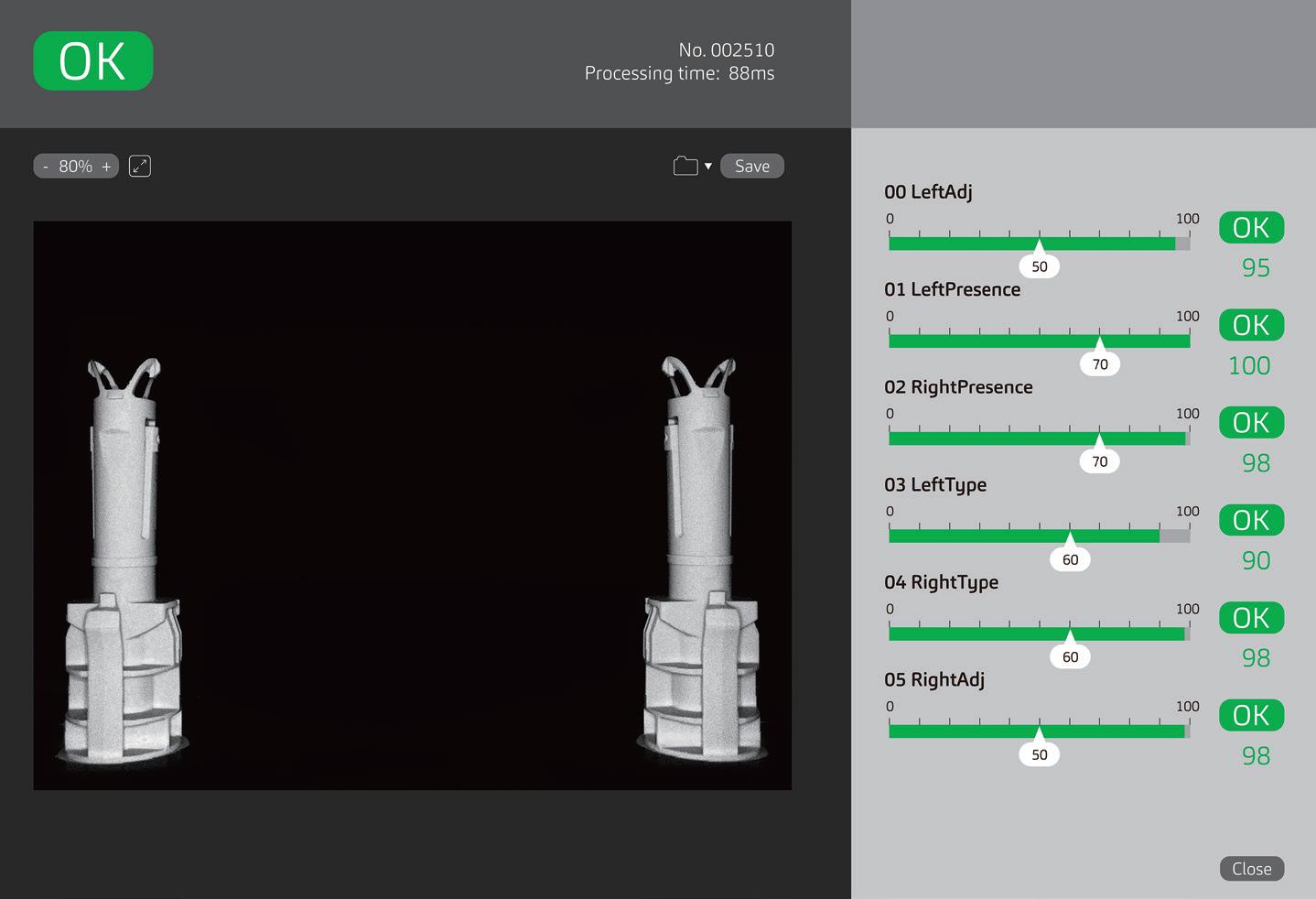
“Leveraging
its inherent versatility enabled by a modular infrastructure, the SMART introduced full automation without altering the device design.”
consistent and accurate results at significantly higher speeds. They quickly adapt to changes and requirements for different products, demonstrating strong adaptability and flexibility. Automated vision systems also collect comprehensive
statistical and image data, which can be used for tracking, analysis and continuous improvement using technologies such as artificial intelligence (AI) and deep learning.4
In 2020, the SMART was selected for a newly approved molecule for atopic disorders – a combination product that leveraged SHL’s Molly 2.25 autoinjector platform. With the drug’s recent launch, production flexibility – as well as uncompromised quality – was crucial to the project. Leveraging its inherent versatility enabled by a modular infrastructure, the SMART introduced full automation without
Colby Chen is a Senior Mechanical Engineer and Team Leader at SHL Medical’s Automation Systems Department. He leads the team responsible for the R&D of new automation machines and modules, proposing technologies and solutions with enhanced product performance and reliability. The team has successfully developed cutting-edge automation systems for autoinjector assembly, including the SMART assembly machine. Mr Chen specialises in design for manufacturability, design for assembly and tolerance analysis processes, with extensive experience optimising designs for production efficiency and quality.
Ian Chang is a Senior Control Engineer and Team Leader at SHL Medical’s Automation Systems Department. He is responsible for developing and deploying software control systems for SHL’s customised and platform-based assembly machines. In this role, he established a standard software modulation architecture as well as a new documentation protocol to increase the efficiency and clarity of the development process. The initiatives not only streamlined project workflows but also significantly reduced development time for new assembly machine projects.
altering the device design. In addition, it seamlessly executed various quality control measures covering 100% of components and sub-assemblies.
The success of the SMART platform signifies SHL’s commitment to addressing the varying needs of its customers and their patients, as well as society in general. Engineered with flexibility, quality and efficiency at its core, the SMART revolutionises high-mix/lowvolume manufacturing by empowering pharmaceutical and medtech companies to leverage the benefits of full automation for their low-to-medium-volume projects. Looking ahead, SHL will continue advancing its modular equipment technologies to further support its customers in their missions to bring life-changing treatments to patients worldwide.
SHL Medical is a solutions provider in the design, development and manufacturing of advanced drug delivery devices, such as autoinjectors and pen injectors. The company also provides final assembly, labelling and packaging services for leading pharmaceutical and biotech companies across the globe. With locations in Switzerland, Taiwan, Sweden and the US, SHL Medical has successfully built a strong international team of experts that develops breakthrough drug delivery solutions for pharma and biotech customers. These include advanced reusable and disposable injection systems that can accommodate large volume and high-viscosity formulations – and connected device technologies for next-generation healthcare.
1. Chung L, Fluetsch G, “Modularizing Assembly and Testing Equipment for Auto and Pen Injectors”. Conference Presentation, PDA Universe of Pre-Filled Syringes and Injection Devices, Gothenburg, 2019.
2. “SHL Medical shortlisted for the CPHI Pharma Awards 2022”. Press Release, SHL, Oct 2022.
3. “What is PackML?”. Web Page, OMAC, accessed Jun 2024.
4. Gertz F, Fluetsch G, “Applications of Deep Learning in Medical Device Manufacturing”. ONdrugDelivery, Issue 110 (August 2020), pp 6–11.









Poster Abstract Deadline: August 1, 2024





Here, Michael Wiglenda Global Senior Director Technical Competence Center & Moldmaking, Germany, at Gerresheimer Medical Systems, describes the company’s approach to the industrialisation of drug delivery devices, using the production of Gerresheimer’s Gx Inbeneo® cartridge-based autoinjector as an example.
As a full-service provider, Gerresheimer Medical Systems provides comprehensive support to its customers throughout all phases of the development process, from the initial conception of an idea to series production. Gerresheimer possesses extensive experience and expertise, as well as the accompanying technical infrastructure, in large-scale production across all stages of the product development process. The company maintains substantial resources in the development, industrialisation and manufacture of delivery systems and components for a wide range of APIs, including inhalers, pen injectors, autoinjectors and glass or plastic syringes.
Whether customers want to implement an initial product idea, further develop an existing development state or have a fully developed product optimised for materials and mass production, Gerresheimer has the expertise to deliver. The company’s core competencies also include injection moulding, including further processing, and worldwide logistics. Through standardised processes, Gerresheimer creates products that meet the specific requirements of an API and the needs and
demands of users and patients, including the functional technical and technological production requirements, user-friendliness and appealing design.
Gerresheimer’s state-of-the-art measuring and analysis equipment, including industrial computed tomography (CT) scanners, enables faster and more cost-effective development of drug delivery systems. By integrating design for manufacturing (DfM) principles from the outset, the company is able to reduce development times and costs. Gerresheimer is a wellestablished expert in processing the two primary materials of the drug delivery industry: glass and plastics. This expertise enables pharmaceutical customers to ensure that their primary packaging and the drug delivery device come from a single source and are optimally co-ordinated.
Gerresheimer’s Technical Competence Centers (TCCs) play a significant role in the company’s offering and deliver specialised services that ensure high-quality and efficient production processes. Worldwide, over 600 engineers, technicians and designers in the TCCs use simultaneous engineering to streamline the entire product development process and ensure that
“Gerresheimer’s state-of-the-art measuring and analysis equipment, including industrial CT scanners, enables faster and more cost-effective development of drug delivery systems.”

Michael Wiglenda
Global Senior Director Technical Competence Center & Moldmaking, Germany
T: +49 9431 639 6730
F: +49 9431 639 89 6730
E: m.wiglenda@gerresheimer.com
Gerresheimer Regensburg GmbH Oskar-von-Miller-Str. 6 92442 Wackersdorf
Germany
www.gerresheimer.com
products are designed for mass production from the outset. Among the key services offered by the TCCs are:
• Development and construction of small-series and large-scale moulds and special-purpose assembly equipment
• Development and construction of measuring equipment
• Sampling and process engineering
• Material-specific, physical and chemical analysis
• Optical and tactile measurements
• Functional measurements
• Qualification and validation of moulds and assembly equipment
• Production of development samples, clinical samples up to smallbatch production in accordance with ISO 14644-1 ISO classes 7, 8 and 9 or GMP classes C and D, respectively.
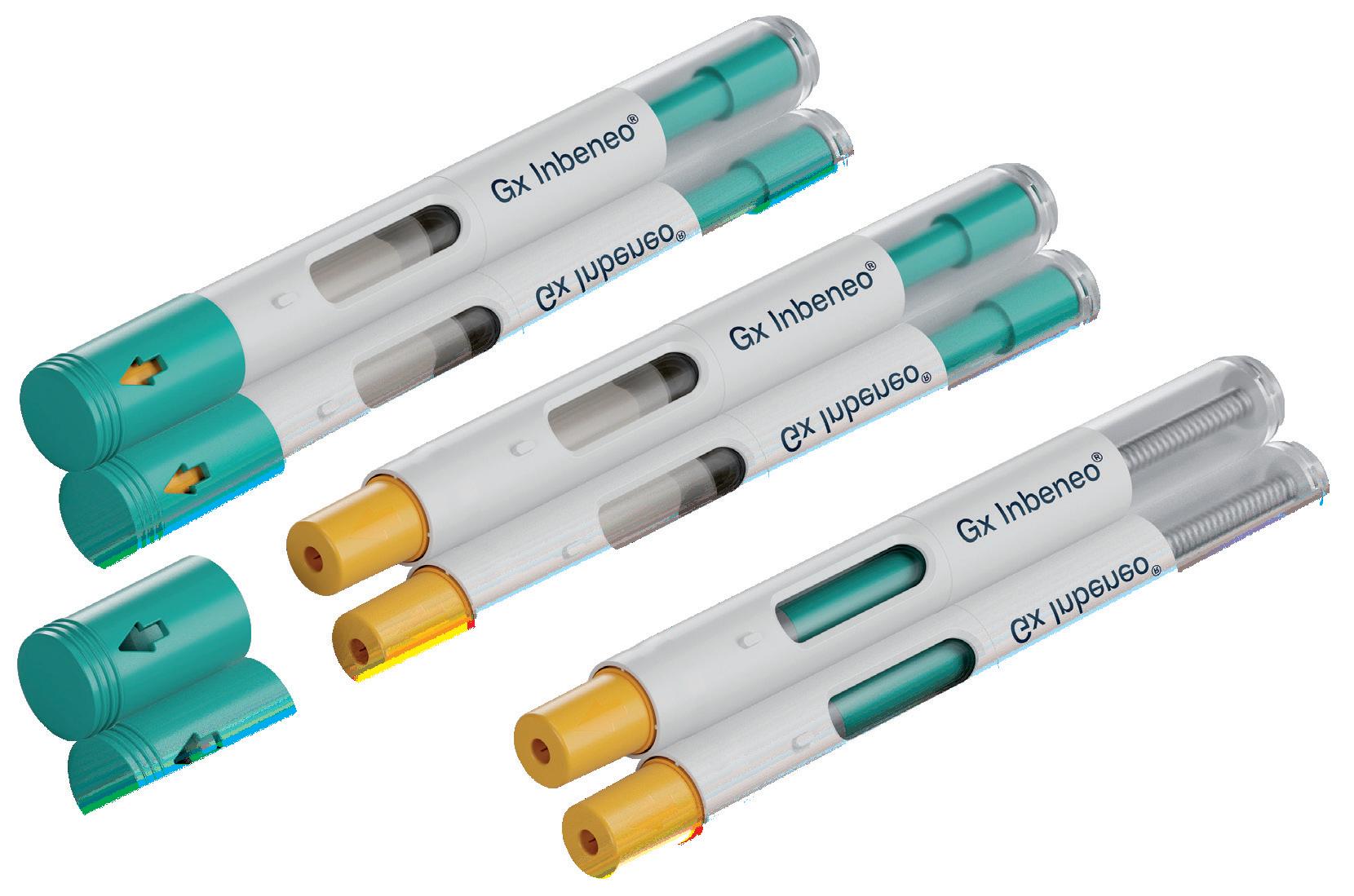
The internationally located TCCs also co-operate with each other. For example, the industrialisation expertise of the TCC in Wackersdorf (Germany) is also used for Gerresheimer’s platform solutions. The “Innovation Center Smart Devices/ Digitalization” in Olten (Switzerland) has developed a disposable autoinjector for subcutaneous administration in co-operation with Midas Pharma (Ingelheim, Germany). This platform solution has now been optimised and industrialised at the TCC in Wackersdorf.
DISPOSABLE AUTOINJECTOR PLATFORM SOLUTION:
GX INBENEO® AUTOINJECTOR
The Gx Inbeneo® autoinjector is a cartridgebased autoinjector system based on pressurised cartridges (Figure 1). During storage, there is no contact between the needle and the medication, ensuring that the needle remains dry. The disposable autoinjector is also compatible with cartridges that have a baked-on silicone coating.
The Gx Inbeneo is centred on the patient experience, featuring a push-on-skin activation mechanism instead of a trigger button, a partially transparent housing that allows for real-time visualisation of the injection progress and a protected needle both before and after injection. The platform solution is suitable for needles with different diameters for subcutaneous applications, is compatible with spring forces of up to 100N and can be adapted for both 1.5 and 3 mL ISO cartridges.
subcutaneous drug delivery.
At the beginning of industrialisation, the basic concept of the Gx Inbeneo was optimised by the product development department in Wackersdorf in co-operation with Gerresheimer’s experts in its moulds and automation sectors, both in terms of design and function, including the addition of some features and consideration of design for large-scale production. Production processes were developed and validated, among which was the development of the sterilisation process. Furthermore, a sterile packaging system was developed and implemented and joining processes were defined and validated.
The Gx Inbeneo consists of two assemblies with a total of 12 injection-moulded components, meaning that 12 moulds need to be designed and qualified in-house by Gerresheimer’s moulds division. In this case, moulds with two-to-four cavities were built. Among them were moulds for overmoulding cannulas (Figure 2).
In the case of the mould for overmoulding the cannulas, the cannulas are inserted into the mould fully automatically with the “double grind” (cannulas sharpened on both sides). The automated tool takes over control of the cannulas from the robot and they are fixed in the mould by means of vacuums. The position of the inserted cannula is continuously monitored using sensors, ensuring a high level of process reliability.
Before the mould was built, a proof of principle (PoP) was carried out to ensure that the envisaged tool function sequence (cannula positioning, cannula fixation and monitoring) was expedient and feasible. The result of this PoP was so promising that the technology for positioning and fixing the cannula was used not only in the tool but also in end-of-arm tool handling in an almost identical way.

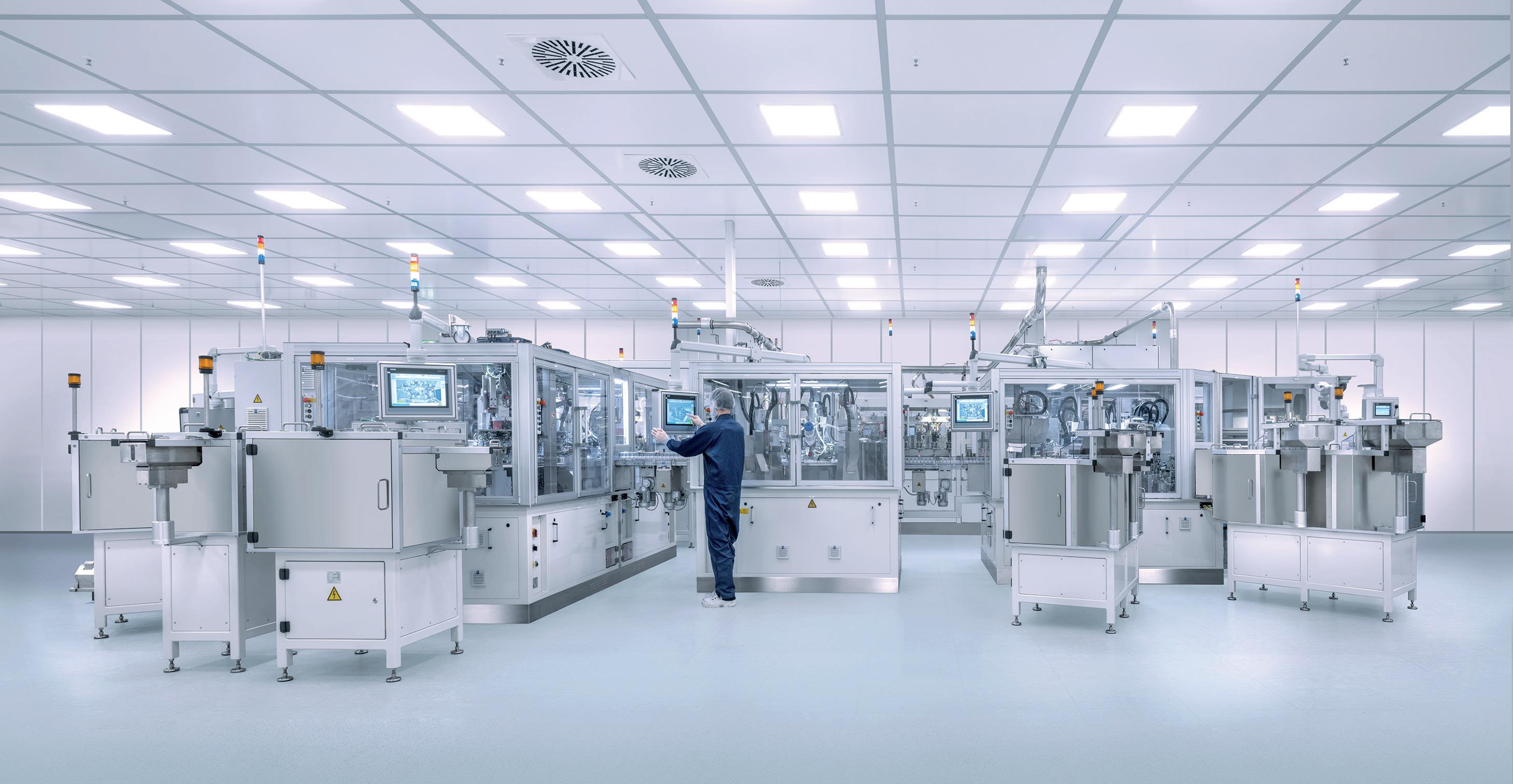
In preparation for production, a DfM package was created in co-operation with the development department. The component design was comprehensively evaluated for feasibility in the mould and production reliability to ensure the stable manufacturability of the components. This early co-ordination reduced the throughput time of the moulds, as the mould design began with optimised component data.
This project implemented an innovative approach by parallelising project phases II and III. This meant that the DfM phase and mould-making ran concurrently. While the feasibility of components and specifications was being co-ordinated between the moulds and development departments, the moulds were already being designed.
This parallel approach necessitated close and intensive communication and co-ordination between all involved departments but, by parallelising the project phases, a significant reduction in project lead time was achieved. Crossdepartmental, integrated project planning was carried using cPlace (Munich, Germany)
management software. The high degree of standardisation designed into the moulds also contributed to increased efficiency. Standard parts were preferentially used to shorten mould-making timelines and improve maintainability.
This project introduced groundbreaking advancements in mould-making through the implementation of “digital part drawings”, with product manufacturing information dimensioning performed by the development department. These digital drawings enable clear surface allocation with the associated part dimensions, revolutionising the process of creating measuring programmes in the measuring room.
Additionally, article toleration was largely carried out by means of geometrical product specification (GPS) toleration. This method describes not only simple attributes, such as diameters, but entire geometric surfaces. This approach requires increased precision in the creation and optimisation of injection-moulding tools, as well as in process discovery and control. To be able to carry out appropriate tool optimisations for GPS-tolerated geometries, “reverse engineering” was sometimes used. This technique made it possible to correct the geometries and surfaces in three dimensions.
“This parallel approach necessitated close and intensive communication and co-ordination between all involved departments but, by parallelising the project phases, a significant reduction in project lead time was achieved.”
Together with the development and construction of the special-purpose equipment required for moulds, Gerresheimer offers its customers highperformance automation solutions (Figure 3). In the pharmaceutical industry, automation, precisely co-ordinated with the product, project and processes, can have a decisive influence on the quality and economic efficiency of production. Gerresheimer’s 120-member automation team supports product development with automation competency, develops automation solutions and specifies, designs, builds, procures and qualifies automation lines.
Gerresheimer not only covers the plastics sector with customer-specific assembly lines, testing systems (including pressure, flow, optical features and forcedisplacement measurement systems), robots for inserting and removing parts, packaging systems, pre-series equipment and pharmaceutical assembly systems, it also develops innovative technologies for glass forming and automation. This has resulted in a new generation of glass-forming systems for syringe production at the TCC in Wackersdorf, which includes patented processes and offers faster cycle times and higher production accuracy.
At Gerresheimer, automation is not an afterthought; it is an integral part of the product and process development journey. This proactive approach ensures
“At Gerresheimer, automation is not an afterthought; it is an integral part of the product and process development journey.”
that automation expertise and know-how are embedded from the very beginning, shaping the product concept throughout the
design phase. This means that Gerresheimer does not wait until mass production to develop automation solutions, but instead develops them in the prototype and preseries phase, which leads to significant time savings in the industrialisation phase.
The creation of high-volume assembly lines is carried out by Gerresheimer’s internal machine builder in co-operation with renowned external machine builders. Product inspection is completed by intelligent inspection systems, some of which are developed internally by Gerresheimer.
To meet the demanding production requirements of the Gx Inbeneo

autoinjector, Gerresheimer built a highly sophisticated handling system (Figure 4). To facilitate the assembly of plastic components for the Gx Inbeneo autoinjector, Gerresheimer built three semi-automated assembly lines (Figure 5), in which the processes used for high- and low volume productions are equivalent.
In 2023, Gerresheimer established a “small-batch production sampling” area in its Wackersdorf TCC, where “drive-in parts” – samples for running-in systems – can be produced in series quality (Figure 6). The establishment of this area reflects Gerresheimer’s adaptation to the evolving project landscape, characterised by an increasing prevalence of largescale industrialisation projects involving numerous moulds and complex automation systems. Industrialisation projects require a large number of drive-in parts in documented series quality at a very early stage for their high-volume assembly systems, which the small-batch production sampling area addresses perfectly.
In contrast to development projects, industrialisation projects for high-volume production demand automated tool handling. This is essential to achieve the required cycle times, tool usage and production flexibility. The equipment in the small-batch production sampling area reflects this necessity. Currently, the area is equipped with 10 injection-moulding machines with clamping forces ranging from 175 to 420 tons.

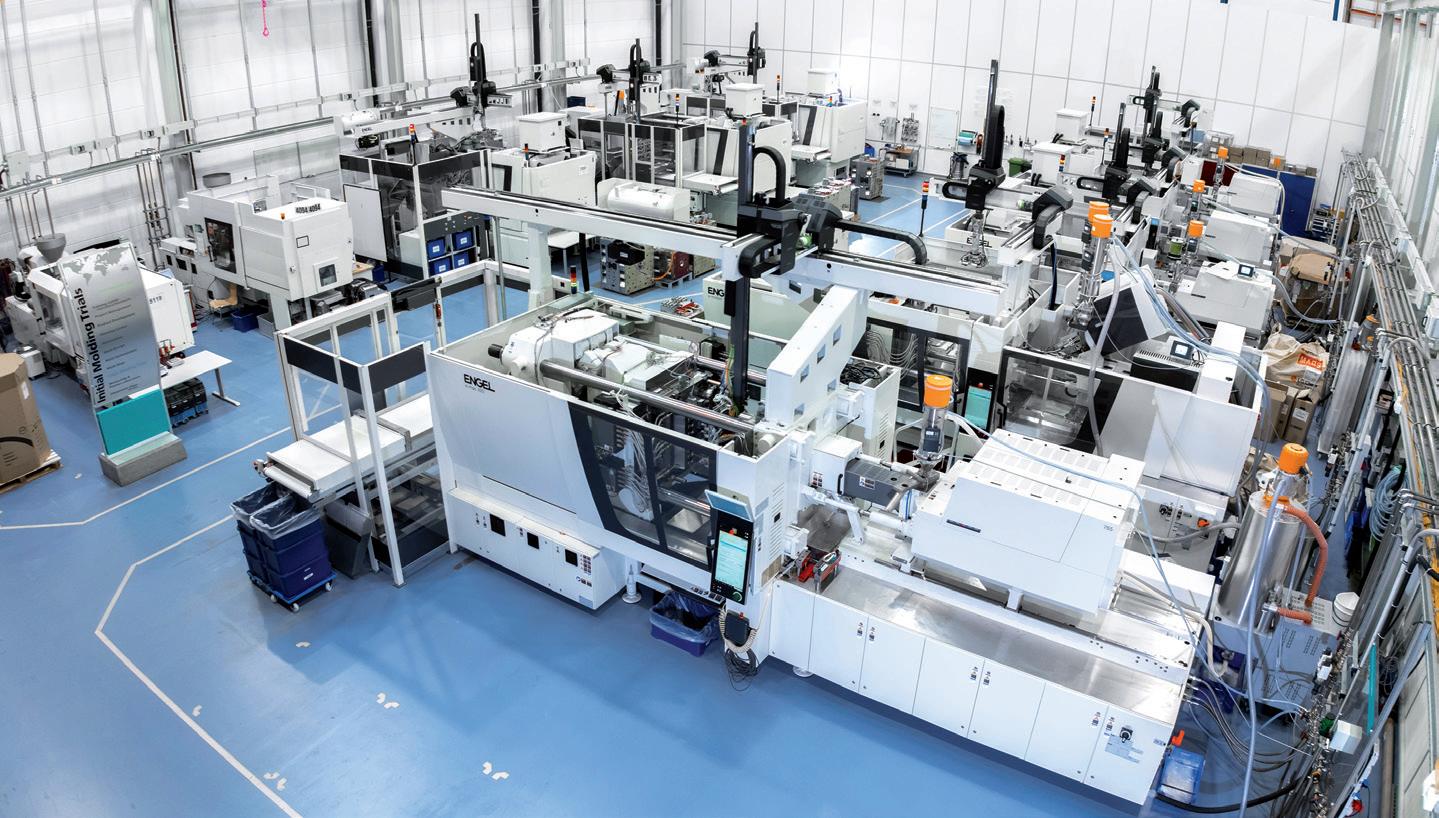
QUALITY LABORATORY: SAFETY
FIRST IN DRUG DELIVERY SYSTEMS
Recognising the paramount importance of safety in drug delivery systems, Gerresheimer meticulously conducts comprehensive testing throughout all stages of product development. This rigorous approach encompasses material analysis, geometric evaluation and functional assessments. Gerresheimer has a measurement laboratory for the geometric measurement of components, assemblies and finished products, a laboratory for material analyses and a laboratory for functional tests with product-specific testing equipment.
Optical and Tactile Technology and Industrial CT Scanning
The use of a measurement laboratory with the most modern measuring equipment available ensures that complex mould inserts and filigreed injection-moulding parts or assembly units can be measured with extreme precision. For the Gx Inbeneo, all components were measured in this laboratory, and the industrial CT scanner was used to identify and address potential issues in the mechanical interaction of components early in the design process. The laboratory’s equipment includes various multi-sensor co-ordinate measuring machines for optical and tactile component measurements, universal co-ordinatereading microscopes and an industrial CT scanner for the destruction-free measuring and testing of individual components or entire assemblies (Figure 7).
Gerresheimer boasts a proven track record of applying CT technology to support numerous development projects,
including the Gx Inbeneo autoinjector. This advanced imaging technique provides valuable insights into the mechanical stresses and resulting deformations experienced by a drug delivery device’s components. CT analysis helps to improve the understanding of force and pressure influences, as well as necessary safety distances and the required piercing depth. This technique makes it possible to optimise prototypes without physically damaging the components.
The advantages of CT scanning are manifold – it provides non-destructive testing and detailed analysis of components, ensuring exceptional product quality and increasing product reliability and safety. In particular, full device assemblies can be tested while assembled. There is no need for time-consuming disassembly, which could also potentially lead to a false result. Early fault detection reduces
the need for costly adjustments in later phases of industrialisation and increases cost-efficiency. After all, the earlier errors in product design are detected by CT scanning, the less complex adjustments are to implement.
This makes design process optimisation possible, especially for simultaneous engineering tasks. The implementation of CT technology in the standardised Gerresheimer phase model leads to a common basis and consistently comparable consideration of results, starting in the concept phase and ending in series production. The accelerated exploitation of results can then be integrated into the product development process.
In the functional testing lab, Gerresheimer develops and qualifies test methods to guarantee compliance with productspecific requirements. The company ensures more safety for patients through comprehensive testing of the physical product characteristics, product-specific performance tests and statistical data analysis during the product development cycle. For example, functional tests were conducted for Gx Inbeneo and aspects such as its spring forces, user forces and dosing times were measured.
Prior to series production, drug delivery devices are put through an exhaustive approval process for which small numbers of units need to be repeatedly produced,

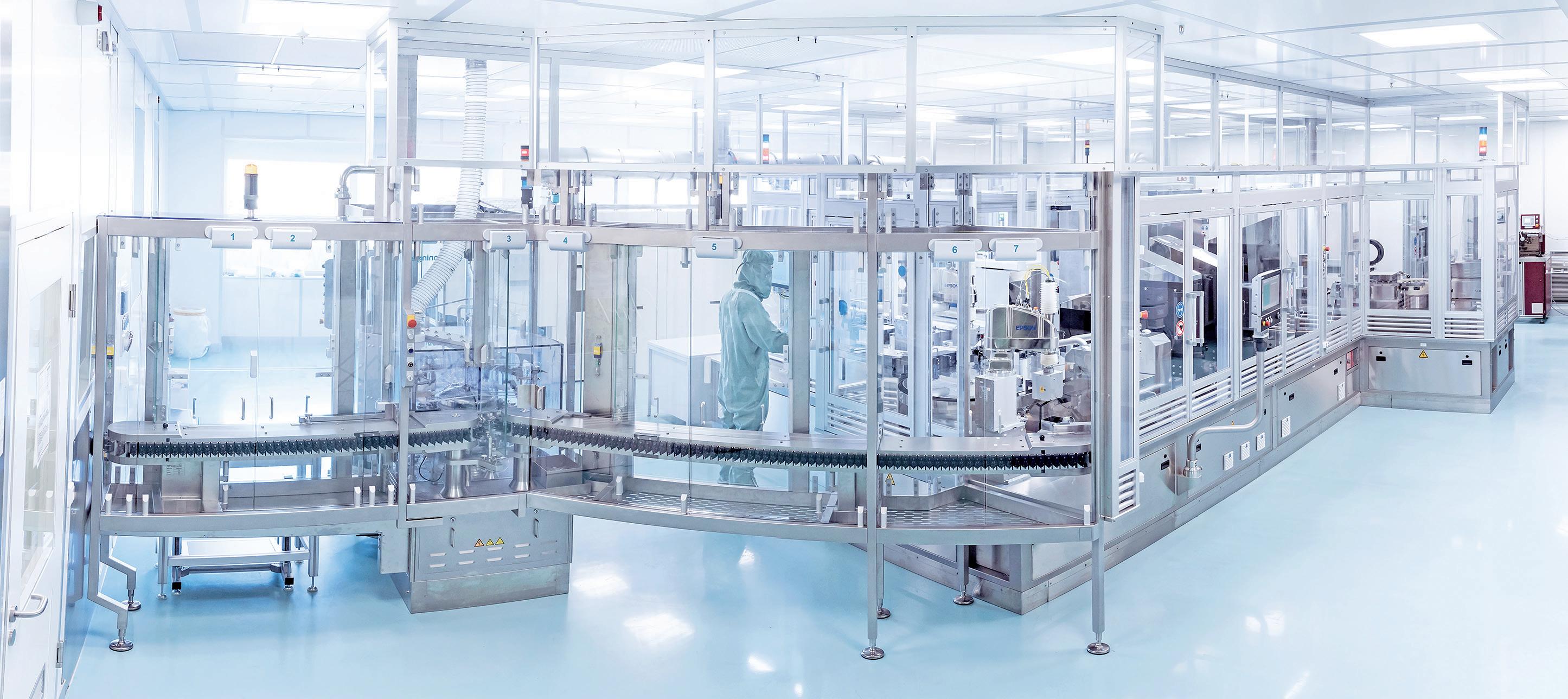
such as for clinical samples, development samples or stability batches. Gerresheimer’s TCCs offer their customers their own production systems for this task, on which the quick and uncomplicated production of development samples, clinical samples or small-series units is possible at any point during a project (Figure 8).
Gerresheimer’s small-batch production also extends to primary packaging. In most cases, these are syringes and cartridges for sophisticated biologic drugs. Gerresheimer also covers the entire value chain and can produce clinical samples for approval or prototypes for process and technology development.
The Gx Inbeneo autoinjector is currently undergoing small-batch production at Gerresheimer’s Wackersdorf small-batch production facility. Small-batch production in this context refers to quantities in the single-digit millions range. Despite the smaller production scale, the small-batch production of the Gx Inbeneo adheres to high-volume standards. This means that the processes employed in small-batch
manufacturing are equivalent to those used for subsequent high-volume production, production environment, data acquisition and documentation as well. In small-batch production, injection-moulding of the single plastic parts, semi-automatic and automatic assembly, and production tests and optical inspections are conducted as normal. The product is printed and packaged. Additionally, Gerresheimer performs sterilisation by means of irradiation, fumigation or autoclaving.
The successful industrialisation of a drug delivery device hinges on a synergistic combination of robust technical infrastructure, streamlined processes and a team of experienced specialists with a wealth of knowledge from past projects. Gerresheimer stands out as a premier partner in this regard, offering a comprehensive suite of technologies and services that span the entire product development and industrialisation lifecycle.
Michael Wiglenda holds an MEng in Mechanical Engineering and has more than 20 years of management experience in the plastics processing industry. Mr Wiglenda heads the TCCs of Gerresheimer Medical Systems in Germany, China and the US as a Global Senior Director. He was responsible for the creation of the international competence centres as well as for the extension of the German competence centre with a pharmaceutical small-batch production. Additionally, Mr Wiglenda is Senior Director of Internal Tool Making.
Early integration of DfM principles and the use of cutting-edge technologies, such as industrial CT scanning, are paramount for achieving time- and costeffective development of high-quality drug delivery products. Gerresheimer prioritises these aspects from the outset, ensuring that products are designed with mass production in mind and tailored to meet the specific needs of the pharmaceutical industry. This applies from the initial idea development to series production and all phases in between.
Gerresheimer is an innovative systems and solutions provider and global partner for the pharma, biotech and cosmetic industries. The company offers a comprehensive portfolio of pharmaceutical containment solutions, drug delivery systems and medical devices, as well as solutions for the health industry. The product range includes digital solutions for therapy support, medication pumps, syringes, pens, autoinjectors and inhalers, as well as vials, ampoules, tablet containers and infusion, dropper and syrup bottles, and more. With 35 production sites in 16 countries in Europe, the US and Asia, Gerresheimer has a global presence and produces locally for regional markets. With around 12,000 employees, the company generated revenues of around €2bn (£1.7 billion) in 2023. Gerresheimer AG is listed in the MDAX on the Frankfurt Stock Exchange (ISIN: DE000A0LD6E6).
Here, Lars Keinicke Hansen, Product Manager, Packaging and Assembly, at Stevanato Group, discusses the potential of technology to enhance the efficiency and productivity of manufacturing processes for both pharmaceutical companies and contract development and manufacturing organisations, as well as the skills and expertise required to maximise the potential gains technology can offer.
While many have come to take them for granted, mobile phones still serve as a remarkable reminder of the pace of change that technology can make possible. The success of the mobile phone in the modern world can be attributed to many things, but one of the most crucial factors has been its flexibility. By downloading an app or software update, it is possible to add entirely new functionality without any major investment or alteration to the underlying hardware. Tasks that previously would have required a separate computer, camera, scanner or satellite navigation device can now all be achieved by a single palm-sized device.
Parallels can be drawn with pharmaceutical production environments, which are also becoming increasingly defined by convergence, integration and adaptability to match the accelerated pace of change. Previously, assembly lines were comparatively fixed, with adjustment or amendment requiring a major investment in time, equipment or skills.
However, times have changed. Today, there is an increased requirement to adapt and adjust production capability at speed to meet changing demands, whether that takes the form of scaling up from benchtop volumes to full commercial production, recalibrating lines according to different device types or satisfying the call for shorter-run production of devices for personalised medicines. A top-line measure of parts per minute is only part of an equation that must also prioritise increased production efficiency and uptime, lower reject rates and the ability for systems to accommodate changes with minimal requirement for ongoing re-engineering. Furthermore, this must all be achieved in light of potentially destabilising macroeconomic influences. In such a competitive landscape, this means innovating to answer shifting patient expectations and needs; managing supplychain resilience in the face of geopolitical unrest; and fulfilling environmental responsibilities through more sustainable use of materials and energy.
“A top-line measure of parts per minute is only part of an equation that must also prioritise increased production efficiency and uptime, lower reject rates and the ability for systems to accommodate changes with minimal requirement for ongoing re-engineering.”

Lars Keinicke Hansen Product Manager, Packaging and Assembly E: lars.keinickehansen@ stevanatogroup.com
Stevanato Group Via Molinella 17 35017 Piombino Dese Padova Italy www.stevanatogroup.com

UNDERSTANDING CUSTOMERSPECIFIC REQUIREMENTS
From an equipment specification point of view, this market context eliminates a onesize-fits-all, plug-and-play model in favour of a fully customised approach to ensure that products, processes and supporting services are all aligned towards maximising production efficiency for the given application. However, bespoke, customised solutions are dependent on suppliers having a clear and deep understanding of the customer and their specific requirements.
This is especially the case with assembly lines for autoinjector devices. Here, there is a universal focus on meeting tight tolerances, challenging geometries and rigorous in-process quality controls. For example, force and distance are critical attributes when handling plunger rods that might need to be positioned precisely in conjunction with a springloaded support pin. However, the journey to the point of production is likely to look different for contract development and manufacturing organisations (CDMOs) compared with pharmaceutical original equipment manufacturers (OEMs).
The CDMO Perspective
For CDMOs, there is an obvious competitive advantage in being able to support a range of pharmaceutical clients in the assembly of multiple different types of generic autoinjector platforms from various suppliers. Commercial success depends on creating flexible foundations that achieve this objective without significant, continuous capital expenditure on multiple assembly lines, while maintaining operational
productivity at consistently high levels and ensuring that products meet critical quality thresholds reliably.
In cases where the same lines manage the assembly of different generic devices, maximising uptime and limiting the time lost to format and batch changeovers become critical objectives for increasing overall productivity and efficiency, getting the most possible out of available resources and saving cost. Stevanato Group’s assembly lines meet this goal through modular design (Figure 1), with their overall functionality delivered via integrated units that are configured to handle various aspects, ranging from in-feed and orientation to laser engraving, labelling and in-line inspection.
Within this structure, process modules can be preconfigured for different autoinjector platforms, while preconfigured
“Stevanato
Group’s assembly lines meet this goal through modular design, with their overall functionality delivered via integrated units that are configured to handle various aspects, ranging from in-feed and orientation to laser engraving, labelling and in-line inspection.”
recipes containing the relevant production parameters can be stored in the assembly line’s control systems in advance. Then, at the point of changeover, the new recipe is selected and the system automatically adjusts to the incoming autoinjector format. With speed in mind, the changeover process is also tool-free. Quick-release and snap-on mechanisms make it simple for key parts, such as grippers and movers, to be exchanged easily. The changeover process is further augmented by the integration of radio-frequency identification (RFID) and sensor systems to verify the accuracy of part placement and ensure that the set-up adheres to the criteria for the specific device being assembled.
The advanced nature of the technology employed in such a system underlines how it is incumbent on suppliers of assembly equipment to deliver not just hardware or software in isolation, but also to contribute value-added tailored wrap-around support. Doing so can ensure that efficient, high-volume manufacture can be deployed to the maximum possible effect. As such, equipment manufacturers should actively and closely support their CDMO customers to help them capitalise on the potential of assembling multiple types of autoinjector on a single, flexible line – a task that is made easier if those manufacturers, such as Stevanato Group, also have extensive knowledge of the end-to-end device production cycle.
The Pharmaceutical Perspective On the other hand, in the case of pharmaceutical OEMs, although no less support is required, the relationship dynamic is notably different from that with

CDMOs, as the focus is not typically on the assembly of multiple types of autoinjectors on the same line. Instead, the challenge is more likely to relate to the optimisation of producing a particular device at high volume and high quality.
To meet this challenge, Stevanato Group adopts design for manufacture principles when establishing assembly and packaging lines for pharmaceutical OEMs. This wellrecognised approach means that processes are optimised in a way that allows products
to be developed and assembled at volume in the most cost-effective way. Flexibility remains a key feature, of course, with consideration given to the likely future evolution of the device and its assembly requirements. This potential is embedded in the customer journey, with transparent technology transfer from prototyping and benchtop assembly through to a GMP-compliant pilot line and fully automated commercial production.
A valuable way of bringing design and manufacture closer together throughout this journey is the use of digital twin technology (Figure 2). A digital twin is a virtual 3D copy of a physical assembly line, with algorithms and artificial intelligence employed to simulate the reality of production as closely as possible. By providing such an accurate replica of the real-world set-up, a digital twin can provide many cost- and time-effective advantages to the design, development and ongoing optimisation of assembly lines.

“By creating a powerful visualisation of the assembly line, the digital twin can be a valuable tool for change-management.”
From a skills perspective, operators and technicians can engage with a digital twin to familiarise themselves with the equipment prior to it being fully commissioned. In addition, any proposed alterations and updates to the system can be simulated on the digital twin to verify their benefit to performance or to highlight any issues or potential friction points, such as the interface between hardware and software. If an issue is detected, the ability to debug and problem-solve in a virtual environment can smooth and accelerate the process of running-in new system elements, helping avoid the bottlenecks and time losses this often creates in live production environments.
At a broader level, by providing a powerful visualisation of the assembly line, the digital twin can be a valuable tool for change-management. It gives a company –whether a CDMO or pharmaceutical OEM – a unique view of the assembly line as it will be, allowing for virtual adjustments to be made and tested before they are replicated in real life. This capability reduces the likelihood of more significant and costly re-engineering being needed at a later point.
When the physical assembly and packaging line is fully operational in the real world, the use of data continues to be a key focus. By capturing and analysing operational data on the fly, a live picture of the line’s performance can be painted in real time. Historically, this capture and analysis process would have to be undertaken after the machinery has been stopped, which can result in delays while also increasing the risk that important issues are not even flagged until they have escalated into disruptive problems. However, by collecting data in real time, operatives can furnish data analysts with rich information that allows them to spot issues as they arise, opening the door to potential remedial interventions or pre-emptive measures that are designed to tackle the issue before it becomes too problematic.
In this situation, data are intended to augment rather than replace the expertise of operational and technical staff. The data provide otherwise invisible intelligence that can inform judgements, challenge assumptions and avert the need to rely on instinct alone. This underlines the critical importance of balancing technical capability with human insight in any production environment.
Stevanato Group acknowledges that, while the equipment within its assembly and packaging line portfolio delivers all the required functionality for flexible, scalable manufacture of autoinjector
Lars Keinicke Hansen is Product Manager for Packaging & Assembly at Stevanato Group. He boasts extensive technical experience and management skills to deliver assembly and packaging solutions for the pharma industry. Mr Hansen has a BSc in mechanical sciences from VIA University College in Horsens, Denmark. Before joining the company, he worked as a mechanical engineer and project manager in charge of assembly equipment for insulin pen injectors, assembly lines for plastic syringes, packaging lines for vials, syringes, cartridges and process equipment for catheter production.
devices, arguably, the most valuable aspect of its offering is the intelligence of its team. The company’s experts offer both extensive technical knowledge and the emotional intelligence to understand the unique demands of each customer, enabling the team to support them with customised assembly solutions and valueadded services that meet their particular evolving needs.
In a world that is only becoming more complex, technology plays a vital role in enabling people to do so much more than they could before – just look at how mobile phones now allow people to do everything from making payments to managing their money and monitoring their health. Likewise, in pharmaceutical manufacturing, technology now enables companies to manage the assembly of incredibly complex devices with more efficiency and flexibility than ever before. However, it is only by having the skills to harness and apply that technology that companies will be able to effectively answer the demands of a continually changing market in the years to come.
Founded in 1949, Stevanato Group is a global provider of drug containment, drug delivery and diagnostic solutions to the pharmaceutical, biotechnology and life sciences industries. Stevanato Group delivers an integrated, end-toend portfolio of products, processes and services that addresses customer needs across the entire drug lifecycle at each of the development, clinical and commercial stages. Stevanato Group’s core capabilities in scientific research and development, its commitment to technical innovation and its engineering excellence are central to its ability to offer value-added solutions to clients.

When pharma and CDMO partners need high precision, high quality, high yield assembly solutions, they turn to Stevanato Group.
Our GMP-compliant device sub-assembly and final assembly equipment can be configured to adapt to your production requirements, providing technology transfer from prototyping to high volume production. This modularity also enables for different formats or devices to be run on the same line, reducing time-to-market.
